David E. Grogan's Blog, page 4
February 15, 2023
LCDR Joe Dwigans, U.S. Navy – From an Iowa Dairy Farm to Flying Navy Helldivers
The naval aviator training pipeline is grueling. It takes months of study to learn the basics of flying. It takes strength of body and mind to withstand the physical and mental strains of landing a plane on the pitching deck of an aircraft carrier at sea. Most of all, it takes courage, to launch from a ship in the middle of the ocean in search of a target with the hope of accomplishing the mission and returning home safely. Few have what it takes to even try to meet naval aviation’s high standards and even fewer succeed. At the height of World War II, with the naval war against Japan raging in the Pacific, Lieutenant Commander Joe Dwigans, U.S. Navy (Retired), raised his hand and said I can do it. This is his story.
Joe was born in his parents’ farmhouse in Stuart, Iowa, in 1921, the oldest of three children. His father had been drafted into the Army near the end of World War I and was on his way to Europe in a troop ship when the war ended. The ship turned around and Joe’s father made his way back to Iowa where he married Joe’s mother and started a family. In 1927, he accepted a job at the Veterans Administration (VA) Hospital in Knoxville, Iowa, and moved Joe and the rest of the family there. They lived on a farm and after a while, a friend asked Joe’s father to keep a dairy cow for him so the friend’s family would have a supply of fresh milk. He took the opportunity and ran with it, eventually growing the herd to thirty dairy cows. The family’s dairy farm supplied fresh milk to lots of families in the Knoxville area.
The dairy farm kept the entire family busy, even during the lean years of the Great Depression. In addition to helping take care of the cows, Joe earned twenty-five cents a week from a paper route, which he kept all through high school. For that meager sum, Joe could attend a cowboy show at the movies on Saturday, pay for popcorn and a Snickers bar at the show, and still put five cents away so he could say he wasn’t broke.
Even more profitable was a rabbit business Joe and his dad ran in conjunction with Joe’s paper route. Joe’s father raised the rabbits on the farm and had them stacked in cages six high. As the rabbits got older, their cages worked their way up from ground level until they reached the top of the stack, indicating the rabbits were ready to sell. On his paper route during the week, Joe took orders from his customers for the rabbits. On Friday night, he delivered rabbit filets wrapped in wax paper to his waiting customers. Joe also hunted squirrels for his mother. She would tell him how many she needed, and Joe and his dog would bring them back in time for dinner.
Another aspect of Joe’s paper route had longer-term consequences. The newspaper operated an autogyro – a fixed wing propeller-driven plane with an overhead rotor like a helicopter – which it used to get around the state to cover stories. When the autogyro was in Knoxville, the newspaper boys went to see it. On one such occasion, the pilot offered Joe a ride. He took it and from that moment on, he set his eyes on flying.
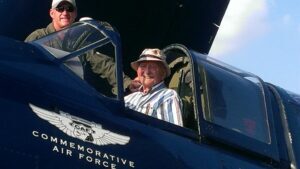 Joe Dwigans sitting in the cockpit of a Commemorative Air Force SB2C Helldiver
Joe Dwigans sitting in the cockpit of a Commemorative Air Force SB2C HelldiverBesides his paper route and helping with the family dairy farm, Joe attended school, eventually going to Knoxville High School. Although he was in excellent shape from working on the farm, he was too small to play sports. Still, he wanted to letter, so he convinced the football coach to let him be the team manager. Although his title sounded fancy, what it really meant was he had to do all the dirty work for the team. And, as if that wasn’t enough, he worked as a clerk at J.C. Penney’s Department Store in Knoxville.
Joe graduated from Knoxville High School in May 1939 and enrolled at the University of Iowa in Iowa City in the fall. He took aptitude tests to see what he should study, but none came back with clear guidance, so he registered for general classes. To pay for his room and board, he worked at the university hospital, busing food to the polio wards. To earn spending money, he asked his former boss at the J.C. Penney store in Knoxville for a recommendation so he could apply for a job at the J.C. Penney store in Iowa City. The recommendation worked because when he went for an interview, the Iowa City store manager simply asked him when he could start. Thereafter, he worked at the Iowa City store whenever he had free time.
In September 1939, war broke out in Europe with the Nazi invasion of Poland. When Germany invaded France in May 1940, Joe’s father saw the writing on the wall. He told Joe to come home after finishing his freshman year to work on the dairy farm until he was drafted. Japan’s attack on Pearl Harbor plunged America into the war in December 1941, but it wasn’t until November 1942 that Joe finally received his draft notice in the mail.
In December, Joe reported as directed to the community hall in Knoxville, together with the other local men who had received draft notices. Joe stood in line until they called his name. At the first desk, they asked him whether he wanted to go Army or Navy. Having spent far too much time toiling in the mud and dirt on the dairy farm, he chose Navy. He then walked to the Navy desk, where they offered him various service options. Recalling his ride on the newspaper’s autogyro, Joe said he would like to give flying a try. Thus began Joe’s journey to becoming a naval aviator.
Joe’s first stop was the Naval Flight Preparatory School at Cornell College in Mt. Vernon, Iowa, a small town about 125 miles northeast of Knoxville. The Navy directed him to report to the school in the spring of 1943, where he joined other officer candidates hoping to become naval aviators. The new arrivals lived in one of the college’s dorms and ate their meals together at Bowman Hall. The training, which lasted about three months, indoctrinated the men into the Navy and placed a heavy emphasis on physical fitness. The training was rigorous and designed to begin weeding out those who could not deal with the physical and mental stress associated with being a pilot in combat. Any candidates not meeting the requirements were dropped from the program and sent to boot camp to become enlisted sailors.
In addition to the physical training, Joe and the other candidates attended classes to learn the basics about being an officer and did lots of drills and marching. While Joe was in excellent physical shape, he found himself competing against many college athletes who wanted to be pilots, too. He roomed with three other men in a dormitory room, one of whom had attended a military school before being drafted. He drilled Joe and the other two roommates until they became experts. During a competition that pitted Joe and his roommates against teams from the other four-man rooms, they took first place. The recognition was fleeting, as the next day they were back to their normal routine of classroom training, drills, and physical fitness.
After successfully completing the Naval Flight Preparatory School at Cornell College, Joe and his fellow officer candidates transferred to a small college near Safford, Arizona, for initial flight training. They learned to fly in civilian aircraft like the Piper Cub, often flying twice each day. The training assessed the candidates’ aptitude for flying and, like the Naval Flight Preparatory School before, weeded out those not suited for the cockpit. The big cut occurred when it came time to solo, with the candidates flying without their instructors for the first time. Joe enjoyed flying and did well, allowing him to advance.
Joe next reported to Pre-Flight School at Saint Mary’s College in Moraga, California, a small town in the San Francisco Bay area. This training emphasized physical fitness and teamwork. To develop these attributes, Joe and the other men participated in team sports, primarily football. The Navy chose football because it was a physical sport with lots of contact, helping build in all the candidates the toughness they needed to meet and defeat their enemies in combat. Again, Joe’s smaller build proved a disadvantage, particularly on the gridiron. Fortunately, the San Francisco Bay area fog proved an unwitting ally. During one morning football game, a dense fog rolled in over the field. The fog was so thick, the players could hardly see each other even though they were standing right next to one another. When Joe took his position on the line, he saw he stood opposite Bruce Smith, an All-American football player from the University of Minnesota. Knowing he was about to be crushed, Joe dropped to the ground as soon as the center snapped the ball. No one saw him because of the fog, and he lived to play another day.
The Pre-Flight Training swimming requirements proved another challenge for Joe. Coming from central Iowa, he never learned to swim. He was not alone, because about thirty percent of his fellow officer candidates couldn’t swim either. To avoid being washed out of the program, they had to learn to swim and survive in the water. As an added incentive, if they did not pass their swim requirements for the week, they could not go on weekend liberty in San Francisco. This forced Joe to stay on campus on more than one weekend doing remedial swimming until he could satisfy the requirements.
Although the swimming requirements kept Joe from going out on the town, he found another way to have fun. By coincidence, an old girlfriend of his from Knoxville High School had moved to San Francisco, so he gave her a call. He told her although he could not go off campus, she could visit him. And, if she brought a carload of girls for his friends, that would be even better. She obliged, and she and her friends came to St. Mary’s for dances with Joe and the other candidates unable to go on liberty. As a result, both Joe and his former girlfriend became very popular.
Another way to get off campus was the Glee Club, which periodically performed around the local area. Joe decided to give it a try and auditioned for a spot. The director allowed him to join provided he promise not to sing a word out loud. Joe readily agreed and got the opportunity to go with the club on one of its performances. The best part was, a family in Oakland hosted him for a home-cooked meal and he had an amazing view of San Francisco from their house.
When Joe was able to go on weekend liberty with his buddies, they usually had little money to spend and could not afford to pay for a hotel room. The Hotel Leamington in Oakland, California, came to the rescue by opening its second floor to the officer candidates at no cost. The downside was they didn’t get rooms – they had to sleep in their uniforms wherever they could find an open space. That was all they needed, and the Hotel Leamington became their base of operations whenever they went in town.
Although the pre-flight training at St. Mary’s focused on physical fitness and team building, there was also an important classroom segment. Joe and the other candidates learned the basics of naval aviation, seamanship, communications, and aircraft and ship recognition. At the conclusion of the program, they were finally ready to learn to fly military aircraft.
After Pre-Flight School, Joe transferred to Naval Air Station Livermore, California, for Intermediate Training. This fourteen-week course began at NAS Livermore and consisted of both ground school and flight training. Joe learned the basics of flying in the two-seat Stearman Model 75 biplane, which he and the other candidates dubbed the “yellow peril” because of its bright yellow paint job and the inexperience of the students flying it.
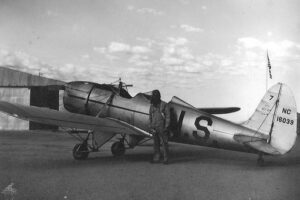 Joe Dwigans standing next to an open cockpit Ryan STA trainer
Joe Dwigans standing next to an open cockpit Ryan STA trainerOnce he’d mastered the Stearman, Joe moved on to the next phase of Intermediate Training at Naval Air Station Corpus Christi. This phase involved more advanced training in the North American SNJ trainer, known as the “Texan” by Army-Air Corps pilot trainees. Joe spent many hours flying the SNJ around south Texas, including over the vast King’s Ranch. He practiced take-offs and landings at outlying fields around Naval Air Station Corpus Christi and learned to fly with instruments rather than just visual flight rules. This phase of the training had a thirty-percent attrition rate, as it was the final cut before the candidates earned their wings. For Joe’s final check ride, he was dismayed to see his evaluator was “Down-Check Charlie”, who was notorious for failing pilots on their final rides. Although Joe was sure he flew an acceptable ride, he became another of Down-Check Charlie’s victims and didn’t pass.
Disappointed with the result, Joe spoke to one of his instructor advisors. The instructor asked him what happened, and Joe said he thought he had done okay. While they were talking, the instructor noticed Joe wearing a Masonic ring and asked him about it. Joe said he had recently been inducted. After the conversation, Joe got a second check ride with another instructor and passed with flying colors.
Joe and his fellow aviation candidates finally earned their pilot’s wings and were commissioned ensigns (O-1) in the U.S. Naval Reserve upon completion of their fourteen-week Intermediate Training. When Joe and the other new ensigns returned to their barracks after the commissioning ceremony, they found a Navy Chief (E-7) waiting for them with a can of polish and a rag for each of them. He told them to go to their rooms and polish the doorknobs until they shined enough to pass inspection. It was a not-so-subtle reminder to keep the new naval aviators from becoming too full of themselves.
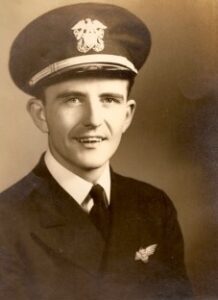 Joe Dwigans in uniform displaying his naval aviator’s wings
Joe Dwigans in uniform displaying his naval aviator’s wingsAfter spending the better part of the last year together, the new officers went their separate ways. Their next task was to learn to fly the Navy’s combat fighters, dive bombers, and torpedo planes in preparation for battle against the Japanese fleet in the Pacific war. When Joe and his friends were asked what type of aircraft they wanted to fly, their first choice was the scout and spotter planes launched from battleships to help pinpoint targets for the ships’ big guns. They thought being one of only two or three pilots on the battleship, they would be a big deal. No one received that assignment. Instead, Joe was designated to fly the Curtiss SB2C “Helldiver”, the next generation dive bomber after the Douglas SBD “Dauntless”, made famous during the Battle of Midway by sinking four Japanese aircraft carriers.
Joe transferred to Naval Air Station Jacksonville on the coast of northeast Florida to learn to fly the Helldiver. Since he would eventually take off and land his plane from aircraft carriers at sea, he had to learn to navigate over open ocean with no reference points to help him get his bearings. This meant being able to look at the wave tops to estimate windspeed and direction so he could take them into account when plotting his course on the plotting board in the cockpit. He also had to learn to fly a triangular course that would take him to his target and bring him back to his starting point where he could land safely. To make the calculations more difficult, if his starting point was an aircraft carrier and the destination was enemy ships, both would be moving, so a course had to be plotted to where he thought the ships would be in the future, not where they were at the start of the mission. If Joe made a mistake, the consequences could prove deadly, because arriving at the wrong place could leave him with little fuel and nowhere to land. As one pilot Joe knew said, “I got lost once and made damn sure I never did again.”
On one occasion, Joe flew his Helldiver out over the ocean with a foreign pilot flying another plane. They flew into a bank of fog so dense Joe could not see the other pilot’s aircraft. He was also unable to contact the pilot by radio. Joe completed the training flight and returned to the airfield, only to find the foreign pilot waiting for him. He had decided to return to base rather than fight the fog. The flight proved the importance of being able to fly on instruments, rather than relying on only what Joe could see. Without his instruments telling him where he was, he could have become disoriented and flown his plane into the sea.
On another occasion, Joe and his fellow pilots went to the officers’ mess to get some lunch before their afternoon flight. Joe didn’t like the looks of the chicken concoction the cooks had put together, so he passed on the meal. Once all the planes got into the air and started forming up, the pilots began vomiting in their cockpits and scrambled to land as they became deathly ill from food poisoning. When Joe landed and saw the condition of the other pilots and their planes, he was glad he had decided to fly hungry.
Joe was also given the opportunity to fly the SBD Dauntless dive bomber, some of which had been brought back to the United States after the Battle of Midway. The pilots were admonished not to dive the planes because they were war weary. Joe volunteered to give the Dauntless a try, and as soon as he reached altitude, he checked the dive flaps and nosed over into a dive – just what he had been told not to do. When he reached what he thought was an appropriate altitude, he started to pull out of his dive. What he didn’t know, though, was that the Dauntless had a “mush” when pulling out of a dive and it used up most of the altitude he had left. When he finally leveled off, he found himself low to the ground and with the mesquite trees passing very close by. It was a lesson he would never forget.
To teach the Helldiver pilots to land on the Navy’s fleet aircraft carriers, which had flight decks less than 850 feet long, the pilots practiced take offs and landings on runways painted with markers simulating the available space on a carrier’s flight deck. Once Joe and the other pilots became comfortable making short take offs and landings, they progressed to taking off and landing on the USS Guadalcanal (CVE-60), an escort carrier with an even shorter flight deck operating off the coast of Florida. To successfully land on the Guadalcanal, Joe had to approach the stern of the ship flying low and slow and then catch the plane’s tailhook on one of three arresting wires crossing the flight deck. Joe’s first landing was particularly unnerving, because when the Landing Signal Officer at the stern of the ship signaled him with his paddles to cut his engine’s power to land, he could no longer see the ship below him. On a leap of faith, he cut power as directed. When his Helldiver caught the arresting wire and it jolted to a safe stop, he knew what to expect going forward. After completing six carrier landings, Joe was designated carrier qualified.
Landing on aircraft carriers wasn’t the only skill Joe needed. To accomplish his mission, he also had to be able to put his plane into a steep dive and drop up to 2,000 pounds of bombs onto an enemy ship zigzagging below at high speed and firing anti-aircraft guns at his plane to destroy it. One of the places Joe practiced dive bombing was on target ships in Lake Michigan. To get there, Joe’s squadron flew their planes from Jacksonville to Naval Air Station Gross Ile, just outside of Detroit. From there, they navigated across the state of Michigan to attack targets on the lake.
During one such practice bombing, Joe’s squadron spotted a ship towing a yellow target vessel. They attacked it with dummy bombs and scored several direct hits, sinking the target. When they returned to the airfield, they were summoned to the tower and told the vessel they sank wasn’t a target – it was a pleasure craft under construction being towed through the target area. Aside from getting chewed out, no one got in trouble because the vessel was not supposed to be in the restricted zone in the first place.
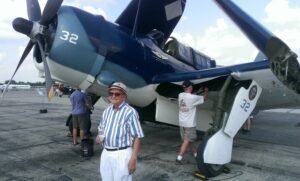 Joe Dwigans standing in front of a Commemorative Air Force SB2C Helldiver
Joe Dwigans standing in front of a Commemorative Air Force SB2C HelldiverOnce their training was complete, Joe’s bombing squadron, VB-75, became operational. It was scheduled to deploy to the Pacific aboard the soon-to-be commissioned Midway-class fleet aircraft carrier USS Franklin D. Roosevelt (CV-42); however, World War II ended with Japan’s formal surrender on September 2, 1945. As a result, Joe and his squadron never flew aboard the carrier or deployed.
Although the war was over, Joe’s flying days were not. His squadron participated in several victory parades, including one over Washington, D.C., where the planes flew in formation down Pennsylvania Avenue at an altitude of just 1500 feet. On another flight out of New York, Joe asked his gunner if he wanted to see anything. His gunner, an enlisted sailor from Tennessee, said it would be nice if they could see the Statue of Liberty. Joe did just that, circling the Statue of Liberty so close it seemed he could reach out and touch it.
When the parades stopped, it was time for Joe to go home. Because he’d been in the Navy since early 1943, he had sufficient demobilization points to be released before the end of 1945. To make his way back to Knoxville, he went in with a pilot friend from Iowa who bought a used car. Together, they made the trip from Jacksonville, Florida, to central Iowa, only to have the car break down an hour outside of town. They were so anxious to get home, they left all their belongings in the car and hitchhiked the rest of the way. They came back the next day and towed the car the remainder of the way, with Joe’s buddy driving the lead car and Joe steering the broken-down vehicle.
Once home, Joe transitioned to civilian life. While he was gone, his parents had sold the family dairy business and purchased an ice cream store in town. Joe cashed in his war bonds and outfitted a freezer truck and made ice cream deliveries to all the surrounding towns. He expanded the ice cream store’s customer base by providing an ice cream freezer free of charge to any store that stocked his family’s ice cream. He expanded even further by making the same deal to schools providing their students with lunches subsidized by the federal government.
The biggest change in Joe’s personal life came in 1948 when he married Betty Rae Grewell. Together, they decided it was time for Joe to finish college. First, Joe took Betty to the University of Iowa in Iowa City, but she was not impressed by the Quonset hut quarters and oil burning stoves. At the suggestion of a friend, they visited the University of Oklahoma in Norman, Oklahoma, and were instantly sold. Using his GI Bill benefits, Joe earned his bachelor’s degree in accounting and stayed an extra year to earn his master’s degree, as well.
Although the GI Bill made his degrees possible, it did not cover all the expenses of his new family. Some of his old flying buddies, who were also at the University of Oklahoma, suggested he fly for the Naval Reserve out of Naval Air Station Dallas. He went to visit and, given his Navy flying experience, was quickly accepted into the Reserves. He flew in a non-pay status for the first three months and thereafter received pay. His Reserve commitment required him to drill one weekend each month and two additional weeks each year. Not only did he make more money in one weekend than he could working all month at a local part-time job at school, but he also got to keep flying, which he loved.
Joe’s service in the Reserves gave him the opportunity to fly all sorts of Navy aircraft. That happened because whenever the active-duty squadrons retired aircraft or received new planes, they sent their excess aircraft to the Reserves. As a result, Joe flew over 500 hours in the venerable Vought F4U Corsair and got to fly the Navy’s first operational jet (the McDonnell FH-1 Phantom) and the Grumman F9F Panther jet fighter. Amazingly, he didn’t attend schools to learn to fly these airplanes. He was simply handed the flight manual and told when he felt ready, he could give the planes a try. Give them a try he did, eventually achieving the milestone of breaking the sound barrier in the F9F. Not only did he fly countless hours around the Dallas/Fort Worth area, but he also flew training missions all around the United States. One of the most memorable of those missions included loitering at a low altitude over San Francisco Bay and watching the city’s lights come on. He can still picture it to this day.
Although Joe loved flying, he decided it was time to stop after a close call in California in 1959. As he was getting ready to take off one morning, his F9F Panther’s engine died. A main fuel line leak caused the failure. The maintenance chief told Joe he was lucky because in every other main fuel line leak he’d seen, the jet had gone up in flames. Joe continued flying for the rest of the fiscal year and then looked for other opportunities in the Reserves.
As for his civilian life, after graduating from the University of Oklahoma, Joe took a job with the accounting firm Arthur Andersen & Company in Dallas, Texas. Now a certified public accountant, he primarily audited oil and gas companies, but found himself traveling a lot. To be able to stay at home with his family, he accepted a position with one of his accounting clients, the Champlin Refining Company in Enid, Oklahoma. After spending three years there, he took a new position with the Trunkline Gas Company out of Houston, Texas, and later shifted to a position with its parent company, the Panhandle Eastern Pipeline Company, in Kansas City, Missouri. After seventeen years with Panhandle Eastern, he worked seventeen more years with the Kansas City Power and Light Company, before finally retiring in 1989.
Joe’s decision to transition away from flying in the Reserves dovetailed with his move to Kansas City. He started drilling at Naval Air Station Olathe, located just twenty miles southwest of Kansas City. Together with men possessing a wide range of backgrounds and talents, he was assigned to a weapons training unit and visited testing sites across the United States. This included nuclear facilities in Illinois, test flight facilities in California, artillery ranges in Colorado, and experimental aircraft testing sites for the McDonald Aircraft Company. Joe stayed in the Reserves until 1971, when he retired as a Lieutenant Commander (O-4).
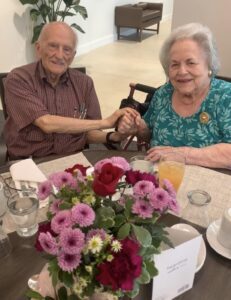 Joe and Betty Dwigans
Joe and Betty DwigansAlthough Joe retired from the Navy over fifty years ago, his Navy service remains a source of pride and accomplishment. He has been an active member of the Naval Reserve Association, helping sponsor University of Kansas Navy ROTC graduates as they embark on their Navy careers. He’s also been active in the Military Order of the World Wars, sponsoring high school students from the Kansas City area to attend leadership schools in Oklahoma City. He’s also the oldest living naval aviator in the Kansas City chapter of the Association of Naval Aviation.
As if that wasn’t enough, Joe has worked with local civic leaders to sponsor high school students to attend the christening of the USS Harry S Truman (CVN-75), and to ride the nuclear-powered submarine USS Jefferson City (SSN 759). During a Tiger Cruise from Hong Kong to Japan on board the aircraft carrier USS Independence (CV-62) with his son, then-Lieutenant Commander Dean Dwigans, who was assigned as the ship’s judge advocate, Joe presented the ship’s commanding officer with a key to the city of Independence, Missouri. In return, the Commanding Officer presented him with a wooden model of the ship, which Joe gave to the City of Independence. Most recently, Joe participated in a Freedom Flight from Kansas City to Washington, DC, in recognition of his many years of military service to our nation.
Joe now lives with Betty in Kansas City. They have four children, Cathy, JoAnn, Cynthia, and Dean, and multiple grandchildren and great grandchildren spread across the United States.
Voices to Veterans is proud to salute Lieutenant Commander Joe Dwigans, U.S. Navy (Retired), for his many years of distinguished service in the Navy. From pilot training through his time as a carrier-qualified Helldiver pilot, he’s answered our nation’s call. He’s continued his service ever since, not only through the Navy Reserve, but also by introducing countless young adults to possible careers in the Navy. We sincerely thank him for his service and sacrifice, and wish him fair winds and following seas.
If you enjoyed Joe’s story, please sign up for the Voices to Veterans Spotlight monthly newsletter by clicking here. Once each month, you’ll receive a new written veteran’s story and a new podcast directly in your mailbox. Best of all, it’s free and you can unsubscribe at any time.
December 14, 2022
Sergeant Russell J. Wright, U.S. Army – Fighting with the Americal Division in Vietnam
Sometimes people are presented with options having life changing consequences. Such was the case with Sergeant Russell J. Wright, U.S. Army, when he received his draft notice in May of 1970. With the war in Vietnam winding down and protestors clamoring for draftees to flee to Canada, Russ could have evaded the draft and kept himself safe from a war that had already killed tens of thousands of Americans. Instead, he chose to do his duty and report for service because he knew it was the right thing to do. Now, looking back on his service in the jungles and rice paddies of South Vietnam over fifty years later, Russ is proud of his service and would do it all again. This is his story.
Russ was born in November 1949 and raised in the small farming community of Bement, Illinois, located in Piatt County approximately 160 miles south of Chicago. His mom and dad operated a family farm, so Russ and his four sisters learned at an early age how to work hard. Russ was driving a tractor by the time he was eight and soon was operating other farming tools, as well. He helped with planting and harvesting corn, with milking dairy cows, and with tending to the pigs. He also learned to handle a rifle safely and loved to hunt pheasant with his grandad.
Although Russ continued to work on the farm throughout his years at Bement High School, he still found time for outside activities. He particularly enjoyed Future Farmers of America, serving as an officer of the school’s club for three years. He was also a manager for the football team for three years, helped with the basketball team in the winter, and played in the band. He graduated from Bement High School in May 1967.
After graduation, Russ enrolled at Parkland Community College in nearby Champaign, Illinois. To pay for school, he worked part-time at the Bement Post Office while continuing to help on his parents’ farm. He graduated with an Associate Degree in Agriculture from Parkland in May 1969 as part of the college’s very first graduating class and began working for the Kaiser Chemical Company at a local fertilizer plant. Then, in November 1969, he received a notice to report to Chicago for a pre-induction physical to see if he was physically qualified for service in the military. Being in excellent physical condition after working his entire life on the farm, Russ passed his physical and returned home, hoping he would not be drafted.
In December 1969, Russ married his high school sweetheart, Debby Tempel. Together with his new bride and a good job at Kaiser, his future looked bright. Then, in May 1970, he received his draft notice with instructions to report for in-processing in June. Although the war in Vietnam was beginning to wind down, the military still needed men and lots of them, and now it was Russ’s turn. Needless to say, Debby and Russ’s parents were shocked, especially with the war and protests against it playing out in the news every day on television, but Russ was committed to serving his country. He had high school friends who were still riding out deferments and he knew some young men who went to Canada to avoid serving, but neither of those options were for him. He considered it his patriotic duty to report as ordered.
On June 10, 1970, together with about five other young men from Piatt County, Russ boarded a chartered bus in Monticello, Illinois, for the trip to the induction site in Chicago. On the way, the bus stopped in DeWitt County, Illinois, to pick up additional draftees. When the bus arrived at the Armed Forces Examining and Entrance Station in Chicago, Russ and his fellow travelers were joined by hundreds of others from across the state being drafted into the military. After getting checked in, eating breakfast, and completing a short follow-on physical to make sure nothing had changed since their pre-induction physicals, the draftees were lined up and told to count off. Every third person was designated as a Marine; everyone else – including Russ – went Army.
After being sworn in, Russ and the other Army recruits were loaded onto buses and shuttled to O’Hare Airport. They were originally slated for Basic Training at Fort Leonard Wood in Missouri, but due to an outbreak of meningitis at the installation, they were instead instructed to board two big charter aircraft en route to Fort Polk, Louisiana. They landed at England Air Force Base in Alexandria, Louisiana, and transferred to buses for the last fifty miles. They arrived at Fort Polk around 3:00 a.m. and were hurried into the transient barracks to sleep, only to be roused at 6:00 a.m. to begin their first full day in the Army.
Despite the lack of sleep and the early start to the day, Russ found the transition to Army life fairly relaxed. They began by marching to chow, followed by in-processing activities for the next week. Russ wasn’t assigned to his Basic Training unit until June 19, and Basic Training didn’t begin until June 22. Even then, Russ found the experience tolerable because the drill instructors were trying out new techniques with Russ’s training company that proved very effective. Instead of the “in your face” approach drill instructors were famous for, they took a firm but fair instruction driven approach. As a result, Russ’s company scored much higher on proficiency tests than most other units.
Something else that made Russ’s Basic Training experience tolerable was his company’s billeting at North Fort Polk due to overflow conditions at South Fort Polk, where most of the training facilities were located. Given the distance from North Fort Polk, Russ’s company trucked to the training facilities rather than march to them as their counterparts at South Fort Polk did. This proved to be a substantial benefit given Louisiana’s high summer temperatures and humidity. Still, Russ felt his instructors prepared him well for what lay ahead.
Russ’s training company consisted of four platoons, with eighty-five percent of the men coming from National Guard units in Illinois, Kentucky, Louisiana, and Texas. Everyone got along well, with a healthy competition evolving in many of the areas of physical training, or “PT”. Russ was particularly good at “low crawling”, which his platoon practiced every night after chow. The men crawled fast on their stomachs twenty-yards out and twenty-yards back, all the time staying as low to the ground as possible. While competitive and fun at Fort Polk, the men knew the skill could save their lives in combat. Overall, Russ scored 95% on his physical fitness test.
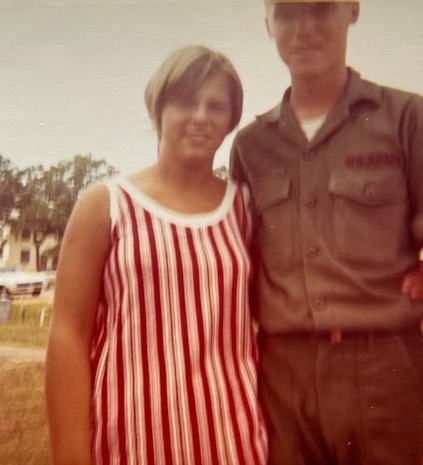 Debby and Russ Wright at Fort Polk, Louisiana
Debby and Russ Wright at Fort Polk, LouisianaBasic Training lasted eight weeks and Russ’s parents, his four sisters, and Debby came to his graduation. After graduation, the new National Guard soldiers returned to their units in their states, while draftees like Russ continued with Advanced Individual Training (AIT), although they were given the weekend off. As Russ’s AIT was also at Fort Polk, all he had to do was pick up his gear and move to the AIT barracks about three blocks away. Even nicer, Debby stayed in Louisiana to be close to Russ throughout AIT. Although she wasn’t permitted to stay on base, she lived about eight miles away in Leesville, Louisiana, visiting Russ in the evening and when he had off on weekends.
AIT for infantry soldiers at Fort Polk was conducted at Tiger Land, where they learned how to fight and survive in the unforgiving jungles and rice paddies of South Vietnam. They spent lots of time at the weapons ranges honing their skills, learned first aid, and practiced map reading. They also trained at night, learning how to conduct patrols and set ambushes. Russ notes the one thing they didn’t learn was how to embark and disembark the helicopters that would ferry them everywhere in Vietnam. All they had to practice on were some static mock-ups, but it wasn’t like the real thing, jumping off a hovering helicopter into tall elephant grass. That Russ had to learn on the job, watching what the other soldiers did and then following their lead.
Toward the end of AIT, Russ and the other soldiers took tests to determine what type of Army job they were best suited for, known as their military occupational specialty, or “MOS”. They were also asked where they would like to be assigned. The test results indicated Russ would do well as a truck driver or a clerk-typist and perhaps one other field. As for locations, Russ selected Germany, Alaska, and Hawaii. After considering his test results and preferences, the Army assigned Russ to the infantry and told all the soldiers they were going to Vietnam. At least for a moment, there had been hope.
Russ graduated from AIT in October 1970 after nine weeks of intense training. He had fifteen days leave before he had to depart for Vietnam, so he and Debby packed their car for the drive back to Illinois. They also found room in the car for two soldiers heading in the same direction, dropping one off in St. Louis and the other in Springfield, Illinois. At the end of his leave, Russ said goodbye to Debby and the rest of his family and boarded a plane in Champaign, Illinois, to start his trek to Vietnam via San Francisco.
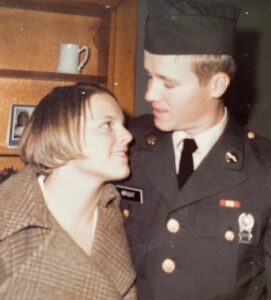 Debby and Russ in Illinois on the night before Russ leaves for San Francisco en route to Vietnam
Debby and Russ in Illinois on the night before Russ leaves for San Francisco en route to VietnamWhen Russ arrived at the airport in San Francisco, one of the first things he witnessed was a bunch of people protesting servicemen returning to the States from Vietnam. He saw the soldiers quickly change into civilian clothes so the protestors would leave them alone. As this was going on, Russ and the other servicemen on their way to Vietnam took a shuttle flight to Oakland, followed by a bus to the Oakland Army Terminal, where they waited until it was their turn to leave. After three days, Russ’s number was called and he took a bus to Travis Air Force Base, where he boarded a chartered Flying Tiger Airlines flight for the final leg of his journey.
After refueling stops in Anchorage, Alaska, and Yokota Air Base in Japan, Russ’s flight landed at Bien Hoa Air Base, located twenty-two miles northeast of Saigon, on November 15, 1970 – just five months after Russ took his enlistment oath in Chicago. As the plane made its approach to Bien Hoa, Russ could see bomb craters in the surrounding countryside, driving home he was arriving in a war zone. When the plane opened its doors, Vietnam’s 100-degree heat and the smell of aviation gas hit Russ and the rest of the passengers all at once. They disembarked the plane and loaded onto buses with wire mesh covering the windows to prevent grenades from being thrown inside – another not-so-subtle reminder of where they were.
Because Russ came to Vietnam as an individual replacement soldier and not as part of a unit, his bus transported him to the 90th Replacement Battalion at Long Binh, located four miles southeast of Bien Hoa. While he waited there to find out what his assignment would be, he ran into some buddies from AIT who were on their way to the 101st Airborne Division. Finally, his assignment was posted – he was on his way to the 23rd Infantry Division (Americal Division), which was headquartered in Chu Lai in the I Corps area of responsibility, in the northern portion of South Vietnam.
Since Chu Lai was almost 350 miles north of Saigon, Russ had to take a C-130 flight to get to his unit. After a two-day layover in Da Nang due to weather, he and another soldier heading to Chu Lai boarded a C-130 for the final sixty-miles of the trip. As the plane descended to land, a fog filled the fuselage. Russ began to panic, thinking it must be smoke and that the aircraft was on fire. The crew chief assured him it was nothing more than fog caused by the hot, moist outside air mingling with the cooler air inside the aircraft as it made its final approach. The crew chief turned out to be right and the plane landed without incident.
Once in Chu Lai, Russ was met by members of his unit and taken to the Americal Division Headquarters, where he checked in. He was then sent to two weeks of combat refresher training to prepare him to join his unit in the field. When he returned from the combat training facility, he bivouacked in a church, together with about fifty other soldiers waiting for barracks rooms. Russ, now a private first class (E-3), celebrated his twenty-first birthday while staying in the church.
Russ was eventually assigned to Charlie Company of the 2nd Battalion, 1st Infantry Regiment, 196th Infantry Brigade. As Charlie Company operated out of Firebase Hawk Hill further north on coastal Highway 1, Russ had to catch a ride on a two-and-half-ton truck (known as a “deuce and a half”) to get to the outpost. Once there, he was assigned to the company’s 3rd platoon, 2nd squad. His job as part of the squad was rifleman, his primary weapon being his M16 rifle.
Russ found the squad immediately welcoming. The squad leader, 1st Lieutenant Rodney Shortell, was squared away and really looked out for his men, as did the company’s 1st Sergeant, Gene Secrist. Everyone in the unit, whether black or white, career Army or draftee, helped each other. Everyone knew that out in the field, they would have each other’s back.
The platoon’s missions followed a pattern. The platoon would go into the field on patrol for up to fourteen days, then return to Firebase Hawk Hill for three days to re-arm, load up with rations, clean their weapons, and relax. Relaxation might involve spending time at the Enlisted Man’s Club, watching an occasional Korean band, or just sleeping. After three days, the platoon would head back into the field and start the cycle over again.
When Russ went into the field, he carried his M16 and a rucksack with 100 rounds of ammunition, canteens filled with water, C-rations, and a bandolier of M60 machine gun ammunition. He also carried a camera in his ammunition belt and a poncho – a critical piece of gear during Vietnam’s rainy season. At night, he could fasten his poncho together with that of a buddy and form a two-man pup tent, which at least theoretically would keep them dry in the rain. When fully loaded, Russ’s gear weighed eighty pounds, quite a load given Russ weighed only 140 pounds at the time. He and the other men often sat down to strap on their rucksacks, but then needed the assistance of another man to pull them to their feet under the heavy load.
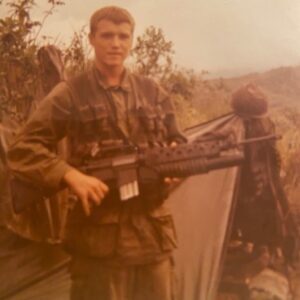 Russ with his M16 rifle equipped with an M203 grenade launcher
Russ with his M16 rifle equipped with an M203 grenade launcherWhen it was time to go on patrol, Russ’s platoon loaded onto helicopters, which ferried them to their jump-off point. Once out of the helicopters, the platoon formed up, with a point man taking the lead and keeping a watchful eye out for booby traps. Although Russ was never the point man, he was often the second man in line, known as the “slack man”. The slack man’s job was to protect the point man and direct him where to go, since he could not do so for himself because he was focused on looking for booby traps. After Russ gained enough experience, he was authorized to carry one of the squad’s two M16s equipped with the M203 grenade launcher. While this gave him considerably more firepower, it also meant he had to wear a grenade launcher vest stuffed with 40-millimeter high-explosive grenades, phosphorous rounds, and fragmentation rounds. Not only did that make his load heavier, but it also made it more dangerous if the ordnance he was carrying detonated.
On one patrol through an area of rice paddies, helicopters could not extract Russ’s squad at the completion of their mission because of incessant rain. The men’s boots became so waterlogged from the rain and trudging through the rice paddies that the skin on their feet started to split open. When it became clear they weren’t going to get picked up anytime soon, the patrol moved to higher ground until the weather cleared. After a while, they started to run out of food, so a soldier from Kentucky killed a wild pig. Although the fire they used to cook the pig might have given away their position, they were so hungry, they were willing to take the chance. After five days, helicopters were eventually able to make it to their position and return them to Firebase Hawk Hill.
Just before Christmas 1970, Russ and five or six other men from his platoon volunteered for a mission at another forward firebase. The week before Christmas and all the week after, they manned a listening post on a hill overlooking the surrounding area. At night, they used starlight scopes to watch for enemy troop movements. When they saw something, they radioed in an artillery strike to eliminate the target. At the completion of their rotation, Russ and the other volunteers from his unit returned to Firebase Hawk Hill and another group of volunteers filled in behind them.
By January 10, 1971, Russ was back in the rice paddies on patrol. As his platoon crossed the paddies, someone started sniping at them and Russ could see the bullets whizzing by. The platoon took cover in a grove of banana trees and pitched camp for the night. When it came time to depart the next morning, Russ’s squad was at the rear, so it was designated the last to pull out. When the lead squad started to move, Russ heard a big boom as the enemy detonated mines, killing two of the lead squad’s soldiers. The two bodies were evacuated by helicopter and the patrol went on.
Later in January, Russ’s squad was resting on a hillside while out on patrol. Russ was playing spades under a poncho when he looked down the hillside and saw two men standing in the creek bed at the bottom of the hill. When Russ pointed them out to the lieutenant, they were identified as Viet Cong and taken under fire. Both men were shot as they ran from the area. The squad recovered AK-47s and a radio from the two men killed. Two more men were also seen running from the area. The squad called in artillery to deal with them.
In February, Russ’s platoon was on patrol in the Central Highlands. As Russ was walking on a narrow mountain trail, he slipped and tumbled 100 feet down the mountainside. The fall injured his ankle and he couldn’t walk, so he had to be evacuated by helicopter and returned to the firebase for treatment. Fortunately, his ankle wasn’t broken, but he had to be put on light duty until he was cleared to go back into the field. When 1st Sergeant Secrist saw Russ was on light duty, he asked Russ if he could type. When Russ told him yes, Russ found himself typing the company’s morning reports until he was taken off light duty.
In late February, Russ and the rest of Charlie Company moved to Firebase Alpha 2 in Quang Tri Province, just south of the demilitarized zone, or “DMZ”, between South and North Vietnam. Their mission was to provide security for the outpost after South Vietnamese Army forces departed to participate in an incursion into Laos, code named Lam Son 719, to disrupt the flow of North Vietnamese supplies down the Ho Chi Minh Trail. Russ’s platoon could see a North Vietnamese camp just across the Ben Hai River with the North Vietnamese flag flying high on a pole over the camp. The sight of the flag so irked some of the men at the firebase that one night they fired a quad-mounted 40-millimeter gun at the flagpole to take it out. The North Vietnamese retaliated with a rocket attack on the firebase. The next morning, the rising sun revealed the pole had been hit and was bent over and damaged, so the unit considered the episode an American victory.
One event near the DMZ that did not turn out well was when Russ’s platoon was called upon to rescue two pilots from a downed helicopter. Although Russ’s platoon raced to the crash site as fast as they could, the North Vietnamese arrived there first and took both pilots prisoner. Russ does not know what became of the captured pilots.
Russ and his company were relieved from Firebase Alpha 2 by the South Vietnamese Army on March 28, 1971. This was the same day that a bloody Viet Cong sapper attack killed thirty-three Americans and wounded eighty-three more at Firebase Mary Ann, another firebase in Quang Tri Province. Consequently, all American units in the area were on high alert.
Charlie Company departed Firebase Alpha 2 and moved to Firebase Rawhide in the vicinity of Khe Sanh, the site of the storied Marine Corps defense against the determined onslaught of the North Vietnamese Army in 1968. The company remained there for a few months, while Russ returned to Firebase Hawk Hill to become the company clerk and mail clerk. Sadly, on May 4, 1971, a member of Charlie Company was killed and two more wounded during a rocket attack by the North Vietnamese Army (NVA) at Firebase Rawhide. Russ had to report these casualties in the company’s morning report, as well as send the deceased soldier’s personal belongings to his next of kin.
At the end of May, both Russ and and the rest of Charlie Company moved to Camp Perdue, a former Marine Corps base southwest of Da Nang. Then in June, Russ was assigned to the Americal Division’s Headquarters and Headquarters Company (HHC) in Chu Lai, where he was responsible for typing the morning reports for various companies in the division. He started out with eight reports, but that number continued to grow until he was doing at least fifteen reports every morning. With the exception of a week of leave he took in July to visit Debby back in Illinois, the morning reports were his primary responsibility through November 1971.
Finally, on November 10, 1971, Russ boarded a blue chartered Braniff Airlines jet in Da Nang to head home. The plane taxied onto the runway, only to stop to allow two battle damaged F-4 fighter aircraft to land. Concern quickly spread among the passengers that they had survived the war only to be exposed to a rocket attack as their plane waited to take off. Finally, the plane was permitted to depart. After the plane took off, the pilot announced when they cleared South Vietnamese airspace. Everyone erupted in cheers.
After a brief stop at Yokota Air Base in Japan, Russ’s plane flew nonstop to McChord Air Force Base, just outside of Tacoma, Washington. Russ proceeded to Fort Lewis, the Army base collocated with McChord, for out-processing from Vietnam. There he received a complementary steak dinner for his service in Vietnam, as well as follow-on orders to Fort Hood, Texas, because he still had time left on his original two-year Army obligation.
Before heading to Fort Hood, Russ flew home to Illinois on thirty-days leave to visit Debby and the rest of his family. Then he and Debby packed their car and drove to Fort Hood to start Russ’s new assignment. They arrived in December and rented a hotel room by the week, having gotten a good deal from the hotel owner, who happened to be from Illinois.
When Russ reported for duty, he learned that although he was a specialist (E-4), he had been selected for promotion while in Vietnam and was immediately eligible to wear the stripes of a sergeant. This not only meant more money for him and Debby, but it also meant he would have greater authority in his new role. Unfortunately, his new role was leading a squad of new recruits learning to work on tanks, which Russ knew nothing about. All he could do was march them to the motor pool, watch them work on the tanks, and then march them back to the barracks at the end of the workday.
This didn’t last long because in January 1972, Russ was offered an early out, which he readily accepted. In his last official act as a squad leader, he took his soldiers out on an exercise where they were the aggressors against a helicopter squadron closing in on their position. As the helicopters drew near, one of Russ’s men fired his weapon equipped with a flash suppressor and the pressure from the blank round firing launched the suppressor toward an oncoming helicopter, breaking its window. Russ’s unit was jokingly credited with shooting down the helicopter. Fortunately, no one in the helicopter was injured and the only damage it sustained was the broken window.
Russ was honorably discharged from the Army on January 21, 1972, having earned two Bronze Stars, two Army Commendation Medals, a Good Conduct Medal, and the Combat Infantry Badge. He and Debby drove back to Bement, Illinois, where Russ returned to work at the Kaiser Chemical Company. Then, in August 1972, he took a job with the Bement Grain Elevator (which later became the Topflight Grain Cooperative), driving an eighteen-wheel truck for twenty-four years and then transitioning to an office position for twenty more. He retired on November 21, 2016, after forty-four years with the company.
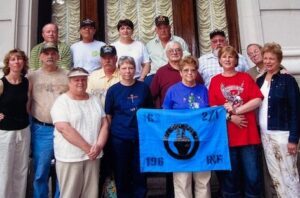 Russ (top row on the far left) and Debby (front row on the far left) at the reunion in 2008 in New Orleans
Russ (top row on the far left) and Debby (front row on the far left) at the reunion in 2008 in New OrleansNot quite forty years after the incident where Russ spotted the two men in the creek bed, he started feeling guilty about causing their death even though they were clearly Viet Cong guerrilla fighters and legitimate enemy targets. What bothered him most was at the time, he had no remorse for their deaths because it was his job to kill enemy soldiers. Debby did her best to help Russ work through it, but it was getting back together with the men of his platoon starting in 2008 that really helped him deal with what he now realizes was post-traumatic stress disorder (PTSD). The group first met in New Orleans, and it was like they hadn’t skipped a beat since they last saw each other in 1971. They subsequently met in North Dakota in 2009 and at Arlington National Cemetery in 2010, where they tried to locate where the two men in their unit killed by the mines on January 11, 1971, were buried.
After learning that one of the men killed, Specialist Allen Gray, was from Belleville, Illinois, Russ returned home and contacted the Belleville newspaper and obtained a copy of Allen’s obituary. This led him to Allen’s brother in Texas and to Allen’s gravesite at the Valhalla Cemetery in St. Louis, Missouri. The men in Russ’s unit and Allen’s family, who did not know how Allen died, arranged to meet at Allen’s gravesite for a memorial service. Soldiers from Kentucky, Michigan, Wisconsin, Texas, and Illinois attended, as did an honor guard from Scott Air Force Base, located in Illinois outside St. Louis. Meeting everyone helped Russ deal with his PTSD and provided a degree of closure for Allen’s family. Russ stays in contact with Allen’s family to this day.
Russ is now retired and lives in east central Illinois, where he has lived since his discharge from the Army in 1972. Sadly, Debby passed away in 2020, but Russ’s and Debby’s four children (Matt, Marcus, Sarah, and Paul), seven grandchildren, and three great grandchildren still live nearby, so Russ has plenty of love and support from his family. He also remains active in both the American Legion and the Veterans of Foreign Wars (VFW), serves in the Honor Guard for veterans’ funerals, and went on an Honor Flight for Illinois military veterans in 2017. He is incredibly proud of his military service and the men he served with, and if called upon to do so, would willingly do it all again.
Voices to Veterans is proud to salute Sergeant Russel J. Wright, U.S. Army, for his dedicated service under fire during the Vietnam War. When the country called, he served willingly, putting himself in harm’s way to protect our freedom and that of our allies. He then returned to civilian life and together with his wife, Debby, raised a fine and loving family. Even while retired, he continues to serve his fellow veterans through the American Legion and the VFW. We sincerely thank him for all he has done and wish him fair winds and following seas.
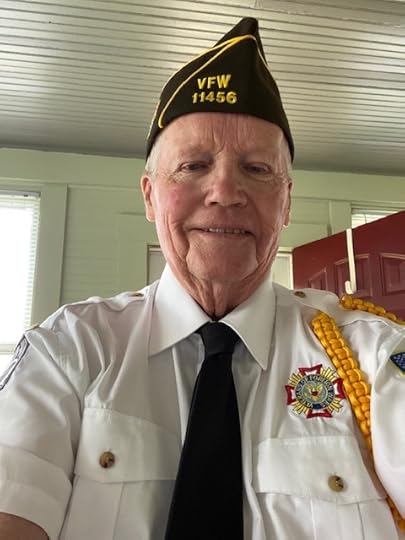 Sergeant Russell J. Wright, U.S. Army
Sergeant Russell J. Wright, U.S. Army
November 9, 2022
Master Chief Petty Officer Donald Gohman, U.S. Navy (Retired) – Keeping the Navy Flying During Three Wars
Master Chief Petty Officer Donald Gohman, U.S. Navy (Retired), is a humble man. When we began to talk, he told me his career was routine and he didn’t think he’d done anything special. Then he told me about how he helped keep planes flying from Henderson Field during the six-month long battle for Guadalcanal during World War II and kept carrier aircraft in fighting shape for missions over Vietnam during the Vietnam War. Needless to say, I was spellbound. Weaving in and out of peacetime and war, Don’s career is a thirty-year American history lesson taught at the individual level. I could not get enough of it, and I think you will share the same view. This is his story.
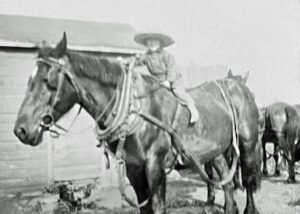 Three-year-old Don riding Maude, one of the farm’s workhorses
Three-year-old Don riding Maude, one of the farm’s workhorsesDon was born in March 1924 and raised in Clear Lake, Minnesota. His parents owned a 240-acre farm, raising cattle, hogs, and poultry, and growing the grain to feed them. As Don was the only child, he learned to carry his weight on the farm at an early age. He drove his first team of horses when he was only five years old. He attended school in a one-room schoolhouse, progressing through the eighth grade. At that point, many children stopped attending school so they could work full time on their families’ farms. Don, however, asked his father if he could attend high school. Don’s father agreed, provided Don continued to do his work on the farm, which he did.
Getting to high school proved to be a challenge, especially in the harsh Minnesota winters. When the roads weren’t covered with snow and ice, Don rode his bike the three-and-a-half miles to St. Cloud Technical High School. When he couldn’t ride his bike, he rode a horse. On one particularly cold morning when the thermometer registered thirty-two degrees below zero, Don asked his dad if he had to go to school. His dad simply asked, “Can the horse make it?” Knowing the answer was yes, Don saddled the horse and headed to school.
Tragedy struck in the summer of 1940 when Don’s father passed away. His mother knew she and Don could no longer maintain the farm, so she sold the farm and took a housekeeping job with a family in St. Cloud where Don continued school. He finished his junior year in 1941, earning money during the spring and summer by working on local farms. The experience made him realize farming wasn’t the life he was looking for. Then he walked past the St. Cloud post office and saw his way out—a recruiting poster with a sharp looking Marine in his dress uniform. Since Don was only seventeen, he spoke to his mother and asked for her permission to enlist, which she gave. Then he headed to the recruiting office to join the Marines.
At the recruiting office, Don found a smartly dressed Marine looking every bit as good as the recruiting poster. Don told him he wanted to be a Marine, but the recruiter quickly dashed his plans. Although Don was in excellent physical shape and could outrun and outwork everyone he knew, the recruiter told Don that at 5’7” and 135 pounds, he was too small to be a Marine. Not to be deterred, Don walked down the hall to the Navy recruiter. There, in stark contrast to the spiffy Marine he’d just left, he found a Navy Chief Petty Officer with his feet up on his desk and his uniform jacket unbuttoned. The Chief asked Don, “Well son, what can I do for you?” Don told him he wanted to enlist, so the Chief asked him what he did. When Don said he worked on a farm, the Chief asked him if he worked with machinery. Don said yes and the Chief told him he had just the job for Don—aircraft mechanic. That was all Don needed to hear. He was ready to join the Navy.
On August 19, 1941, Don and one other recruit from the area boarded a bus and drove to the entrance processing station in Minneapolis. There he took his oath of enlistment and boarded another bus headed for boot camp at Great Lakes Naval Training Station north of Chicago, Illinois. They arrived at Great Lakes early on Wednesday morning, August 20, and immediately marched to the mess hall still wearing their “civvies” (civilian clothes). Breakfast consisted of baked beans, which the mess attendant piled onto Don’s metal tray. After he wolfed them down, a second class seaman (E-2) noticed Don wasn’t drinking his milk and told him to drink it. Don said he couldn’t drink milk and if he did, there would be a problem. The seaman told him to drink it anyway, so Don did as directed. He then threw up the milk and beans he had just consumed all over the table. His reward for being right was he had to clean up the mess, even though it wasn’t his fault. Needless to say, his enlistment was not off to a good start.
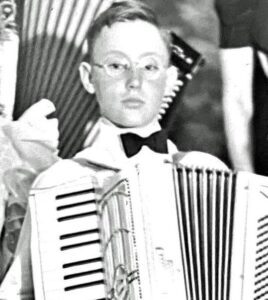 After breakfast, the new recruits marched to their barracks. Although some recruits were assigned bunks (called “racks” in the Navy), Don’s company had to sleep in hammocks like the ones found on older ships. All their possessions had to be stowed in their canvas duffel bags, known as seabags. To make their uniforms fit in their seabags, they had to neatly fold them and then tightly roll them into the smallest bundle possible. They then tied them with clothes stops so they wouldn’t unroll in the bag.
After breakfast, the new recruits marched to their barracks. Although some recruits were assigned bunks (called “racks” in the Navy), Don’s company had to sleep in hammocks like the ones found on older ships. All their possessions had to be stowed in their canvas duffel bags, known as seabags. To make their uniforms fit in their seabags, they had to neatly fold them and then tightly roll them into the smallest bundle possible. They then tied them with clothes stops so they wouldn’t unroll in the bag.
To test their packing skill, every week there was a seabag inspection, where the recruits had to lay all their clothing out on the floor. A lieutenant would then come by with a stick to test whether each recruit’s clothes were rolled tightly enough. During one such inspection, when the lieutenant arrived at the recruit next to Don, he didn’t like the way the recruit’s clothes were rolled, so he picked them up and tossed them out the window. The recruit then had to retrieve his clothes and re-wash them all by hand, which was the only way the recruits had to clean their clothes. Although Don’s clothes passed inspection, the incident motivated him and the other recruits to make sure their seabags were always ready for inspection. To this day, Don folds his socks the way he was taught at boot camp.
Because Don was in good shape when he arrived at boot camp, he had no problem with the physical training. He could run fast and do pushups and pullups, and unlike many of the recruits, he could swim well having grown up swimming and diving in Minnesota’s many lakes. He also played the accordion, which came in handy when his company Chief asked if anyone had any talent they could share with the other trainees. Don’s mother sent him his accordion, which he used to warm up a crowd of 5,000 waiting to watch an exhibition bout involving heavyweight boxing champion Joe Louis. After Don finished playing, Joe Louis entered the ring and shook Don’s hand.
Don’s biggest disappointment came on payday. As a Seaman Recruit (the lowest Navy enlisted rank, or E-1), he expected to receive his full pay of $21/month. Instead, his first pay was just $12.67. When Don asked his Chief why the amount was so small, the Chief told him he had been charged for things like the bucket and soap he used to wash his clothes. Don was pretty sure someone was skimming something off the top of his pay, but there was nothing he could do about it. Aside from that, he thought his Chief trained his company well.
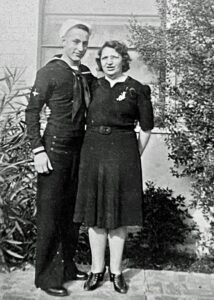 Don and his mom
Don and his momAfter graduating from boot camp in early October 1941, Don took leave to visit his mother and his buddies back in St. Cloud, Minnesota. Much to his chagrin, his mother wanted him to go with her to visit her mother in Centerville, Iowa. Don could think of nothing more boring and was upset he would not get to spend any time with his friends. Once he got there, though, he noticed a pretty fifteen-year-old girl named Darlene living across the street. On his last day in Centerville, he summoned the courage to speak to her and they ended up talking for a couple of hours. Then it was time for Don to go and he boarded a train for his next duty station in Jacksonville, Florida.
In mid-October 1941, Don reported to Naval Air Station Jacksonville for Aviation Machinist Mate school. He specialized in aircraft engine and propeller mechanics, becoming proficient in both areas. He also volunteered for combat aircrew training, which meant he learned how to be a gunner on aircraft that would operate from the Navy’s aircraft carriers. He proved to be an expert shot because of his experience hunting ducks in Minnesota.
On Sunday, December 7, 1941, Don returned to the barracks after church and lunch and learned Pearl Harbor had been attacked by the Imperial Japanese Navy. The news had an Orson Wells-like feeling, with no one believing it could be true. Once reality set in, the atmosphere was subdued, at least until the next morning when Don and the other sailors in his training section were mustered in their summer white uniforms for combat training. They soon found themselves crawling through the grass in their whites, none of them with weapons or any sense of the purpose for the training. From that point on, Don and the rest of the Navy were on a wartime footing.
In February 1942, Don departed Naval Air Station Jacksonville and reported to Naval Air Station Norfolk, Virginia, to continue his training. This advanced-level training included attending two six-week courses at the Curtiss-Wright Engine School and the Curtiss Electric Propeller School. Finally, by the summer of 1942, Don was ready for his first assignment. Initially, that was Marine Corps Air Station, Cherry Point, North Carolina, doing maintenance on aircraft hunting for German submarines off the East Coast of the United States. Then he and the men he was with, about 120 in total, departed Cherry Point by train on a non-stop trip to Naval Station Treasure Island, located all the way across the country on San Francisco Bay. They had no idea what their mission or ultimate destination was. All they knew was they were on a secret wartime mission.
Once at Treasure Island, Don and the other men of his unit loaded onto two rusty Dutch merchant ships. Thirty-two days later, they arrived in Noumea, New Caledonia, a French controlled island located approximately 750 miles off the east coast of Australia. More important, Noumea was located approximately 850 miles south of Guadalcanal in the Solomon Islands, which was about to become the focal point of the Pacific War. Don’s team, now part of a composite unit identified as Acorn Red One and consisting of his aircraft mechanics and a battalion of Navy Seabees, loaded onto Navy transports and headed toward one of the most pivotal battles of World War II.
On August 7, 1942, the U.S. Marines landed on Guadalcanal and quickly captured and secured the main airstrip, renamed Henderson Field after Major Lofton Henderson, the first Marine aviator killed in the Battle of Midway. Two days later, Don and the other aircraft mechanics went ashore, waiting for the Seabees to finish work on Henderson Field and for the arrival of the U.S. aircraft that would operate from the airstrip when complete. By August 18, the field was ready and the first Marine squadrons flew in two days later. Don’s job was to keep the aircraft, dubbed the “Cactus Air Force”, flying so the pilots could attack Japanese Army forces on the island and Japanese Navy forces menacing the waters around Guadalcanal.
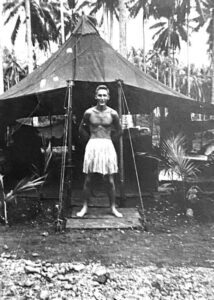 Don in a lighter moment on Guadalcanal
Don in a lighter moment on GuadalcanalThe conditions on Guadalcanal were horrendous. Henderson Field was under constant attack from Japanese ground forces, naval forces, and air forces, especially at night. Powerful Japanese battleships and cruisers periodically shelled Henderson Field from off the coast while every night Japanese bombers dropped bombs on the U.S. defenders below. The nighttime attacks by high-flying Japanese “Betty” bombers became so routine that Don and his friends reacted nonchalantly when the air raid siren wailed. Instead of heading immediately to their shelters, they posted a lookout to watch the searchlights sweeping the sky for Japanese airplanes. Only when the lights appeared directly above them would they take cover; otherwise, they would remain in their tents and try to get some sleep.
During one such attack, the assigned lookout yelled the searchlights were right above them and everyone scrambled out of their tents. Two Japanese bombs exploded nearby, hurling shrapnel everywhere. Fortunately, two big coconut trees that had been made into tables shielded Don from the blast. Otherwise, he is certain he would have been injured or killed by the bombs.
Don and his fellow mechanics did everything they could to keep the planes of the Cactus Air Force flying. Sometimes this meant overhauling engines or replacing propellers, while other times it meant scavenging parts from disabled aircraft or patching bullet holes with tape and painting over it. Don even helped resolve a problem with Major “Pappy” Boyington’s F4U Corsair’s supercharged engine and got to meet the Medal of Honor recipient in person.
Although Don worked on lots of aircraft, he was specifically assigned to maintain a particular Douglass SBD “Dauntless” dive bomber, which meant he also occasionally flew as a gunner on the plane. The theory was if he knew he was going to fly in the plane, he would be especially careful in maintaining it. He and the other maintenance personnel had to sleep under their assigned aircraft in case they were needed on short notice. This was terrifying because individual Japanese soldiers occasionally infiltrated the Marine perimeter around Henderson Field and slit the throats of the sleeping sailors. This memory is particularly difficult for Don even after the passage of eighty years.
When word circulated that the Japanese were going to make a concerted attack to retake Henderson Field, Don’s situation became precarious. Bulldozers pushed a protective berm of dirt around the airfield and Don and other members of his unit were issued M55 Reising guns, which looked like .45 caliber pistols with a rifle stock. Don was shown the defensive perimeter around the airfield and told when the first line of sailors was gone, his job was to fill in behind them and hold the line. Fortunately, the Marines held the perimeter against the Japanese attacks and Don never had to take a place in the line.
As if the constant attacks weren’t enough, tropical rains turned the ground into a deep, thick mud. Bugs and snakes were everywhere, and malaria and dysentery were rampant. Don took Atabrine to fight off malaria, but it turned his skin and urine bright yellow. Occasionally, he used the conditions to break the monotony and play jokes on his fellow sailors. One sailor, in particular, was afraid of snakes. Don found a length of rope on the dock, tied a string around it, and put it under the covers of his friend’s cot. When the friend fell asleep, Don pulled the string and the friend, thinking there was a snake in his rack, came flying off the rack to get away.
Once the situation on Guadalcanal stabilized, beer started to arrive on the island and it became a much sought after commodity. When some of Don’s friends learned a cargo ship had arrived with a shipment of beer, Don and his buddies took a small vessel known as a lighter out to the ship to commandeer their share of the beer. Just after the cargo ship deposited the first load of beer in the lighter, an Australian patrol boat came by blaring that a Japanese submarine was in the area and that the cargo ship should get underway immediately. Before the lighter could clear the area, the Australian patrol boat dropped depth charges on the suspected target. When they detonated, the lighter bounced up, tossing the beer in the water. Disappointed, Don and his friends made their way back to shore empty handed.
Although Don lost the beer, there were other ways to get alcohol. Some of the maintenance team noticed that on their way out to the aircraft on the flight line, they had to walk past a field where flares were stored. The flares were attached to small silk parachutes so that when the flare was fired from an artillery piece, it would slowly descend to the ground, lighting up the night sky as it did. Some of the men cut off these parachutes, painted the Rising Sun on them, and sold them to new arrivals on the island telling them they were captured Japanese flags. The men then used the money they made to buy whatever alcoholic beverage might be available.
Don had to be medically evacuated from Guadalcanal in June 1943 after coming down with malaria. He’d been on the island for ten months, surviving everything the Japanese had thrown at Henderson Field and the Cactus Air Force. Although barely nineteen and a Second Class Petty Officer (E-5), he’d already seen a lifetime of war. Yet for him, the war was just beginning.
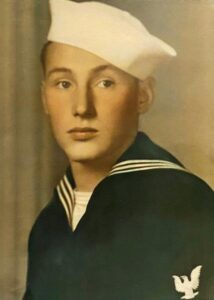 Don in New Zealand
Don in New ZealandDon spent the rest of June and all of July 1943 recuperating in a hospital in New Zealand. The winter weather was a welcome change from the tropical heat of Guadalcanal and his stay was uneventful. At the end of July, he returned to Noumea to find a way back to the States for his next assignment. He managed to get orders to hitch a ride on the USNS Rappahannock, a fleet oiler returning to Naval Base San Diego. On the way back, the ship stopped in Bora Bora, which Don describes as the most beautiful island in the world. Don arrived safely back in San Diego in August 1943.
Once back in the States, Don reported to Naval Air Station Alameda near San Francisco to await orders. While there, he had a second bout with malaria even worse than the first. After he was back on his feet, he made his way to Hawaii, where malaria hit him a third time. This time it was so bad he nearly died. Again, he recovered and caught up with his aircraft maintenance unit on the island of Roi-Namur in the Marshall Islands, which the Marines had already wrestled from the Japanese. From there they went to Tarawa, going ashore in November 1943, just after the Marines stormed ashore in what was to be one of the bloodiest battles in the Pacific War.
Before Don’s unit could begin its work maintaining aircraft on the atoll’s airfield, it had to assist burying over 5,000 of the Japanese defenders killed during the assault. The job got even worse when the smell of death started seeping from a Japanese bunker next to Don’s maintenance tent. Rather than cleaning out the bunker after it had been disabled, the Seabees simply bulldozed dirt over the top of it. Now it had to be opened and Don and the other members of his unit had to go inside and remove the human remains. The odor permeated their bodies. Even after showering and putting on new clothes, they smelled like death. So much so that when the unit entered the chow hall, everyone else left.
In early 1944 and after a brief ordeal with bed bugs on Kwajalein Island, Don and his unit moved to Eniwetok Atoll in the Marshall Islands, which had been captured by the Marines in January 1944. The atoll soon became a major forward staging area. The Navy prepositioned about sixty replacement carrier aircraft at the airfield as part of its theater-wide aircraft pooling strategy. U.S. Navy pilots flew their old or damaged aircraft to the airfield on Eniwetok and returned to their aircraft carriers flying the newer model replacement aircraft. Don and his team either fixed or jettisoned the old or damaged aircraft, making room for more new replacements. As a result, Don became an expert working on all types of Navy aircraft, including the SBD “Dauntless” dive bomber, the TBM “Avenger” torpedo plane, the SB2C “Helldiver” dive bomber, the F4F “Wildcat” fighter, and the F6F “Hellcat” fighter.
When Don first arrived on Eniwetok, though, his group, now numbering about twelve Second Class Petty Officers, had nothing to do because no planes requiring work had yet arrived. Accordingly, they set up their tent near a bakery and found a lieutenant who needed help unloading lighters bringing supplies ashore. In return, the lieutenant allowed them to “borrow” some of the supplies, including real potatoes, ice cream mix, and beer. They then traded some of their supplies to the bakery in return for even better goodies.
The arrangement worked great until one night when the group of twelve was cooking French fries and drinking beer kept on ice in empty ammo cans, they saw a man wearing a khaki uniform approach. This meant he had to be a Chief or an officer. It turned out to be even worse than that—he was the base Commanding Officer (CO). He asked the men how they were doing and one of the men, loosened up by the alcohol, said they were doing just fine and offered the CO a beer. He politely declined and when he learned the group had nothing to do, he put them to work on the airstrip fire crew.
Even though Don arrived on Eniwetok after the fighting was over, there were still grim reminders of the war. One evening, a bomb-laden Navy PB4Y (the Navy’s version of the four-engine B-24 “Liberator” bomber) roared down the runway for takeoff when two of the engines failed. The bomber tore through the pool of parked carrier planes, destroying around twenty-five aircraft and killing everyone on board the PB4Y. A Seabee used a bulldozer to roll the unexploded bombs from the plane away from the burning aircraft, which came to a stop only fifty to sixty feet from Don’s maintenance tent.
Don was still working on Eniwetok when the war with Japan ended on August 15, 1945. He didn’t have long to celebrate because at the end of August he received a telegram from the Red Cross informing him his mother had passed away. To see if he could return home to be with family, he went to speak with his commanding officer. His commanding officer gave him orders to the Naval Air Technical Training Center (NATTC) on the south side of Chicago and he departed soon after. His service in the Pacific and World War II was officially behind him.
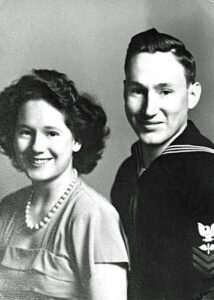 Don and Darlene in 1946
Don and Darlene in 1946Don reported to NATTC in October 1945 as an aviation maintenance instructor. In February 1946, NATTC relocated to Naval Air Station Millington, Tennessee, just outside of Memphis. Before Don moved with it, he wrote to Darlene, the young woman he’d met in Iowa in 1941 after boot camp. After a few drives from the south side of Chicago to visit Darlene in Iowa, Don and Darlene fell in love and were married on Christmas Day 1945. When Don moved to Memphis in February 1946, Darlene went with him.
There was lots to do in Memphis once Don arrived. With the aviation maintenance school having just moved there, everything had to be set up from scratch. Don, now a First Class Petty Officer (E-6), worked in the propeller section and continued to improve his maintenance proficiency by attending various factory schools. He remained at NATTC until September 1949, when he transferred to the Fleet Air Service Squadron (FASRON) at Naval Air Station Oceana in Virginia Beach, Virginia. Again, he was assigned to the propeller shop, where he was a recognized expert technician. In fact, the Chief in charge said, “Gohman, you run the shop and I’ll sign the paperwork.”
Once the Korean War broke out on June 25, 1950, the immediate demand for people, ships, and carrier aircraft threw Oceana’s squadron maintenance schedules into chaos. Don continued to work on F4U Corsairs, Douglas AD “Skyraiders”, and even the new F-9 “Panther” jet fighter. However, in 1951 the personnel demands of the war caught up to him and he was given the choice of either going to sea or returning to the propeller shop at NATTC as an instructor. It was an easy choice—in October 1951, Don returned to Memphis with Darlene. He stayed there until the summer of 1954, when he reported to Commander, Fleet Air Japan at Naval Air Station Atsugi, located twenty-seven miles southeast of Tokyo.
Don’s job at Commander Fleet Air Japan was mammoth. He was responsible for tracking the maintenance status of every Navy airplane in the Western Pacific theater and scheduling its maintenance at factory specified intervals. Given the information he had available to him, his job required a Top Secret clearance. He was also in charge of the factory service representatives, who would fly out to the carriers or the surrounding airfields to perform maintenance on aircraft when the Navy’s sailors encountered problems they could not fix on their own. When the problem stumped even the factory service representatives, Don would fly out to fix the problem.
Darlene and their one-year-old daughter, Becky, eventually followed Don to Atsugi. She and other Navy wives boarded a ship in Santa Clara, California, and sailed across the Pacific to Japan. The trip was miserable, with seasick kids, stopped toilets, and children on leashes whenever they went on deck so they wouldn’t fall overboard. Once Darlene and Becky arrived, they lived with Don out in town in Atsugi, but eventually they were able to live on base and enjoy its American amenities.
One thing Don is most proud of from his time in Japan was climbing Mt. Fuji, the 12,000-foot volcano overlooking Tokyo. Don set out with three members of his staff and twenty-seven other climbers. It started raining when they reached 6,000 feet and sleeting at 8,000 feet. It was so miserable, all but Don and his three companions turned back. Eventually, the clouds broke and they had a beautiful view of the expansive Kanto Plain below. Don still has the climbing stick he used to make the climb, known as a “Fuji stick”. Now he uses it whenever he talks to groups to encourage them to never give up.
 Navy Times article recognizing Don for Schoolmaster of the Year
Navy Times article recognizing Don for Schoolmaster of the YearDon worked at Commander Fleet Air Japan until November 1957, when he again returned to NATTC in Memphis. This time he worked with engine analyzers monitoring spark plugs firing on radial engines. In 1961, he started transitioning into the jet engine field. In 1962, he promoted to Chief Petty Officer (E-7) and earned the Navy’s Schoolmaster of the Year Award after competing against over 2,800 instructors from across Naval aviation worldwide. One of the perks of the award was he got to fly to Mobile, Alabama, several times to appear on a Sunday morning science and physics television show hosted by a noted physicist. Back at NATTC, Don set up the maintenance courses for the T-56 turboprop engine before transferring to his next command.
In February 1963, Don reported to Midway Island in the central Pacific Ocean, located 1,300 miles northwest of Oahu. He was assigned to AIRBARSRON TWO which flew a continual line of the four-engine WV-2 Super Constellation surveillance aircraft on a racetrack course between Midway and the Aleutian Islands. In the days prior to satellite surveillance, these long-range early warning planes painted a constant picture of surface and air traffic in the central Pacific, helping protect Alaska, Hawaii, and the West Coast of the United States and Canada from a possible surprise attack from the Soviet Union. As it had been for so many years, Don’s job was to keep the aircraft flying around the clock, seven days a week. Don also qualified as a junior flight engineer, which allowed him to fly on some of the squadron’s surveillance missions to the Aleutians. The job was stressful and demanding, but once again Darlene, Becky, and now his son, Mark, joined him there in the summer of 1963. They kept themselves entertained by watching the many birds on the island, including the giant albatross known as the Goony bird.
In July 1964, Don transferred to Attack Squadron ONE FIVE TWO (VA-152) at Naval Air Station Alameda in the San Francisco Bay area. The squadron operated the Douglas A-1 Skyraider (formerly the AD Skyraider), which was a powerful single-engine propeller driven close air support aircraft capable of delivering 8,000 pounds of ordnance on enemy targets with great precision. Don was the squadron’s Quality Control Chief Petty Officer, meaning he was responsible for making sure the maintenance was conducted according to standards.
Don deployed with the squadron aboard the aircraft carrier USS Oriskany (CV-34) in April 1965 to participate in the quickly escalating Vietnam War. The ship’s squadrons flew missions over Vietnam from May 1965 through the end of November 1965, before returning to San Diego on December 16, just before Christmas. During the cruise, Don became good friends with the ship’s Catholic Chaplain, Lieutenant Commander William J. Garrity. During a deep discussion in the Chief’s Mess one evening, Chaplain Garrity said he would give his life for the men on the ship, just as Jesus had done for all men. Don pressed him on it, but one year later Chaplain Garrity proved good to his word, helping to lead a dozen pilots to safety after being caught in a horrific blaze that almost sunk the ship in the Gulf of Tonkin off the coast of Vietnam. Chaplain Garrity died in the fire after going back to try to rescue even more trapped pilots. During an Honor Flight Don took to Washington, DC, in October 2022, he made a point of honoring Chaplain Garrity by finding his name on the Vietnam Veteran’s Memorial Wall.
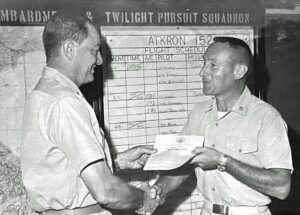 Don promoting to Senior Chief Petty Officer
Don promoting to Senior Chief Petty OfficerNow a Senior Chief Petty Officer (E-8), Don detached from VA-152 in 1966 and returned to NATTC in Memphis. This time he was assigned to the teachers training section, where he screened students to be prospective instructors. Once selected, the students went through a twelve-week course to qualify as an instructor. Don’s job subsequently expanded to be the head of the Quality Control Division, evaluating the performance of the instructors. Finally, he was put in charge of the full operation, covering screening, teaching, and evaluating all NATTC instructors. This meant he was responsible for 1,200 instructors and 6,000 students—it was the biggest job Don held in the Navy and he loved it. It also helped him promote to Master Chief Petty Officer (E-9), the highest enlisted rank in the Navy, as did his efforts to broaden his professional education in areas that would help him be a better leader. This included completing the Third Class Personnelman correspondence course, working with sailors taking the Second Class Hospital Corpsman course, becoming certified in CPR (cardiopulmonary resuscitation) and lifesaving with the Red Cross, earning his GED (graduate equivalency degree), and completing a Psychology I course at the University of Memphis.What he is most proud of during this tour, though, was that he tutored three candidates from his command over three years for the Navy’s Schoolmaster of the Year Award and two of the three won the award.
Don retired from the Navy in July 1971 after a distinguished thirty-year career. Because he loved to teach and be around teachers, he accepted a job as a Building Engineer for the Memphis City Board of Education. As a Building Engineer, he was responsible for keeping his assigned school fully operational so the teachers could focus on teaching their students. When the teachers learned about Don’s background, they often brought him into class to work with the kids. He even made a jet engine for one science class and helped other teachers teach about electricity. Don retired from Memphis City Schools in 1986 after fifteen years.
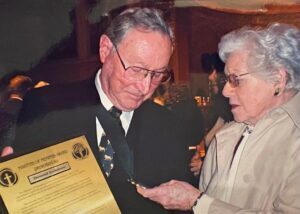 Don and Darlene at a Martyrs of Memphis award ceremony recognizing Don for his work with the poor
Don and Darlene at a Martyrs of Memphis award ceremony recognizing Don for his work with the poorAlthough Don had already earned a well-deserved retirement, he had one more job to do. He had heard through his church that the Monastery of St. Clare, a community of nuns following the example of St. Clare of Assisi, needed someone to help take care of the monastery. When Don arrived at the community, he spoke with the Abbess about the position. She told him she could not pay him much and he said that was okay. Then she said, “In fact, I can’t pay you at all.” It didn’t matter to Don—the nuns needed help and he knew he was the right person. He accepted the position and worked there for 33 years, finally retiring at the age of 95!
Don now lives outside Memphis with his daughter, Becky. Sadly, his beautiful wife, Darlene, passed away on Christmas Day 2018, 73 years to the day after they were married. Don treasures every day he had with Darlene and gives her and other military spouses a special salute. They hold their families together when their servicemember spouses are deployed in far off places. They work long hours and raise their kids without any recognition or awards. Yet their contribution is every bit as crucial and patriotic toward our national defense as their servicemember spouses’. Don is passionate about the importance of military spouses and wants all to realize the important role they play.
In October 2022, Don participated in an Honor Flight from Memphis to Washington, DC, recognizing him for his years of service to our country. During the trip, he visited the World War II Memorial, the Korean War Memorial, and the Vietnam War Memorial, representing the three conflicts spanning his career. Now as he looks to the future, he can’t wait for April 8, 2024, because he will be at ground zero for a 99.9% solar eclipse, not to mention he will have celebrated his 100th birthday the month before.
Voices to Veterans is proud to salute Master Chief Petty Officer Donald Gohman, U.S. Navy (Retired) for his thirty years of distinguished service to our country. From the epic battle for Guadalcanal in World War II to helping USS Oriskany’s aircraft fly combat missions during the Vietnam War, Don served and sacrificed without condition or complaint. From the bottom of our hearts, we say thank you for your service, shipmate. We wish you fair winds and following seas.
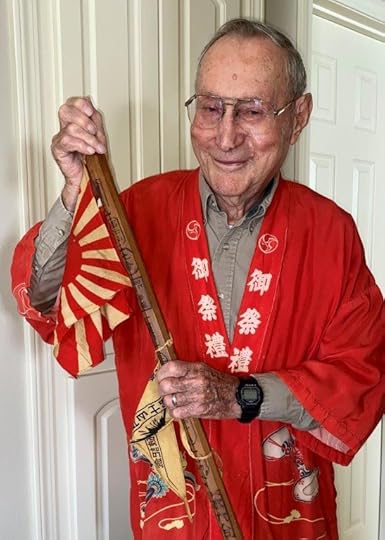 Don in his Japanese “Happy Coat” with his cherished Mt. Fuji climbing stick
Don in his Japanese “Happy Coat” with his cherished Mt. Fuji climbing stick
October 19, 2022
Sergeant Thomas Lucken, U.S. Army – Knocking on the Cold War’s Door
It’s easy to take for granted the freedoms we have because we live in a country isolated from its adversaries by two vast oceans. As a result, most of us live our lives unconcerned with the possibility of an invading foreign army. Many U.S. allies do not enjoy the same luxury, as they find themselves bordered by authoritarian regimes ready to cross their borders at the first sign of weakness. The U.S. has supported its allies since the end of World War II by sending forces to stand with them against would-be aggressors. Sergeant Thomas Lucken, U.S. Army, was one of those soldiers called to hold the line during the Cold War by spending over thirteen years overseas in South Korea and Germany as a Cavalry Scout. This is his story.
Tom was born in Peoria, Illinois, in July 1963, and initially lived in the Quad Cities area of northwest Illinois after his parents moved there from Iowa. In 1967, his parents moved again to Florissant, Missouri, a suburb of St. Louis, where Tom’s father worked as a writer for the St. Louis Globe Democrat. Tom joined the Boy Scouts when he was eight years old, beginning a life-long passion for Scouting he would pass on to his own boys. He also enjoyed hunting and fishing and doing anything outdoors, all skills that would prove useful later in life.
Tom loved sports, so it was only natural he played football when he entered McCluer North High School in 1977. He played football until he injured his knee during his sophomore year and then channeled all his energy into Scouting. During his junior year, Marshall’s Department Store opened in Florissant and Tom got hired as a stock clerk. This meant he had to further divide his time between work, Scouting, and studying, with studying drawing the short straw.
Tom graduated from McCluer North High School in May 1981. While still working at Marshall’s, he enrolled at Florissant Valley Junior College in the fall, but quickly decided that was not what he was looking for. When his mom asked, “What are you going to do with your life?”, he had an answer. A friend of his, Nick Morrison, had been talking to an Army recruiter, and Tom had decided to check it out. So, in September 1981, Tom and Nick visited the recruiting office to see what their options were.
The recruiter sat down with Tom and showed him a book of the available jobs (referred to as Military Occupational Specialties, or “MOS”). When Tom saw one of the jobs was Cavalry Scout and watched a video to see what the job entailed, he was hooked. Being half-Native American and a huge fan of John Wayne, he felt being a Cavalry Scout was in his blood. As a Cavalry Scout, Tom would serve as part of a highly mobile force acting as the “eyes and ears” of the Army, gathering information about enemy positions and relaying it back to main body forces ready to respond. He enlisted in the Delayed Entry Program in October 1981 and reported for active duty on January 11, 1982.
After taking his oath to support and defend the Constitution of the United States, Tom reported for Basic Training at Fort Knox, Kentucky. His recruiter had told him he would attend Basic Training for eight weeks and then transfer to another unit for six weeks of Advanced Individual Training, or AIT, for Cavalry Scouts. However, when he arrived at Fort Knox, he learned he would spend all fourteen weeks training with the same drill sergeant. Drill Sergeant Pack made the announcement with a glint in his eye, “I don’t care what your recruiters said, you’re ours for the next fourteen weeks,” although the original language was slightly more colorful.
About five weeks into Basic Training, Tom’s unit did a forced march to the firing range to begin a week of Basic Rifle Marksmanship (BRM) training. On the way there, Tom sprained his ankle, but didn’t want to say anything to the drill sergeant. Still, Drill Sergeant Pack saw Tom limping a little and asked Tom what was wrong. When Tom replied, “I twisted my ankle, Drill Sergeant,” Drill Sergeant Pack showed no mercy and Tom asked for none – he finished the march back to the barracks. That night, when Tom took off his boots, his ankle was swollen to the size of a softball. His recruit platoon leader, Pedro Vazquez, told Tom they had to let Drill Sergeant Pack know. At first Tom refused, but later relented. When Drill Sergeant Pack saw Tom’s ankle, his eyes widened. He told Tom to report to sick call to get it checked out.
Tom reported to sick call as directed and was told to use crutches for seven days and put on light duty for ten. He still was able to complete his BRM training, but instead of marching to the range, he was driven their because of his ankle. More important, Drill Sergeant Pack treated Tom differently for the remainder of Basic Training. Tom believes it was because he hadn’t complained about his ankle and continued to march even when hurt. He’d proved himself a soldier to Drill Sergeant Pack.
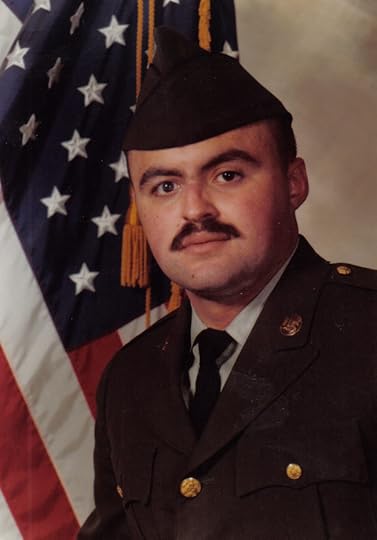 Tom at Fort Knox in 1982
Tom at Fort Knox in 1982Aside from the ankle sprain and living in World War II era barracks, Tom’s experience at Basic Training and AIT was positive. His Scouting and outdoors experiences growing up fit in well with the training and he found himself doing much better than the recruits from cities as they hadn’t had the same experience. It wasn’t all easy, though. They were constantly on the march through the hilly countryside, “up Agony and down Misery,” two particularly notorious hills on the base.
At the end of AIT, Tom was held over one week to learn to operate the M901 Improved TOW Vehicle (ITV), which was an armored personnel carrier modified to carry a TOW missile launcher on the top. After completing this additional training, he was directed to report to Alpha Troop of the 6th Cavalry Squadron, 1st Training Brigade, also at Fort Knox. For the next eleven months, he was responsible for maintaining an M113 Armored Personnel Carrier (APV) and using it to train new recruits. Although he was only an eighteen-year-old Private (E-2) just out of Basic Training and AIT, he was a soldier as far as the recruits were concerned and was already passing on what he had learned.
Toward the end of his assignment with the 6th Cav, Tom received orders to report for duty in South Korea, which was the front line of the Cold War. He arrived in Seoul in April 1983 and spent about three days at the 2nd Infantry Division headquarters and three days at the replacement detachment, both located at Camp Casey, about forty miles north of Seoul. Finally, he reported to his unit, Alpha Troop of the 4th Cavalry Squadron, 7th Cavalry Regiment, at Camp Garry Owen, located about twenty-six miles from Seoul and just eight miles south of the Demilitarized Zone (DMZ) between South and North Korea. If the North Koreans were to launch an attack against South Korea across the DMZ as they did in 1950, Tom’s unit would be one of the forward-positioned U.S. units bearing the brunt of the attack.
Tom realized the seriousness of his assignment when he drove a five-ton truck to Freedom Bridge using the only traffic corridor in the western segment of the DMZ. After passing through a U.S. checkpoint, he saw signs on both sides of the road warning of minefields. He then crossed an old trestle with wooden planks he wasn’t sure were strong enough to support the weight of the truck. From that point on, he knew he had to be at the top of his game all the time or the results could be disastrous.
In June 1983, Tom conducted his first thirty-day rotation with Alpha Troop as an M113 APV driver to patrol the DMZ. The unit’s mission was to support the U.S. infantry battalion defending the DMZ, which was itself on a ninety-day rotation. During its thirty-day mission, Tom’s Troop supplemented the infantry battalion’s patrols on the South Korean side of the DMZ, conducted ambush training, and served as part of the quick reaction force. After three days on patrol, the Troop resupplied for a day before starting the cycle over again.
Aside from the frequent rotations to the DMZ, the only other excitement during Tom’s tour was President Ronald Reagan’s visit to the DMZ in November 1983, but Tom didn’t get to see him. Instead, his unit was locked down at Camp Garry Owen, prepared to react in case North Korea attempted to disrupt the President’s visit.
After completing his one-year tour of duty in South Korea, Tom received orders to report to the 1st Squadron of the 4th Cavalry Regiment, located at Fort Riley, Kansas. The Squadron was the Divisional Cavalry Unit for the storied 1st Infantry Division, known as the “Big Red One”. As part of the unit, Tom operated the M113 APC and the M901 ITV, and occasionally worked with M60A1 tanks. In the fall of 1984, the unit conducted two weeks of training at the National Training Center (NTC) at Fort Irwin, California, becoming the first Divisional Cavalry Unit to do so. The unit spent the first week training in the intense heat of the Mohave Desert, and then spent the second week conducting live-fire exercises.
In January 1986, Tom deployed with the 4th Cavalry to Germany as part of the annual REFORGER Exercise, where the United States and its NATO allies tested their ability to quickly deploy forces to Germany to thwart any future Warsaw Pact aggression. After drawing equipment from Karlsruhe Kaserne near Frankfurt, the units spent two weeks in the field living in tents and exercising with other NATO units. They then reversed the process, stowing their equipment at Karlsruhe Kaserne, and returning to the United States in March. The trip was not entirely work, as Tom visited the site of the 1972 Munich Olympics and drank warm beer in real German restaurants.
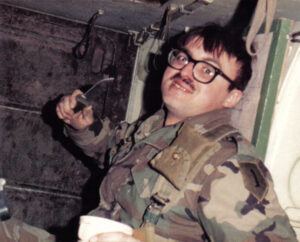 Tom at Fort Riley in 1985
Tom at Fort Riley in 1985Once back at Fort Riley, Tom returned to his normal duties. This included working with the special forces teams training at the repelling tower and running “rope corrals” teaching ROTC officer candidates how to tie knots (who better to do that than a former Boy Scout). During one such knot tying session, a friend of Tom’s from high school came through as an officer candidate. He asked Tom for advice in selecting a service branch and Tom told him the Cavalry was the way to go. A few years later, he learned his friend had taken his advice and was now a Captain commanding a Cavalry Troop in Europe.
As Tom entered his third year at Fort Riley, he began looking at options for his next tour. His friends told him to request duty in Germany, patrolling the border between West and East Germany. He put in several requests, but never heard back. Finally, tired of both Fort Riley and waiting for a response on his Germany request, he put in a Form 4187 request for duty in Korea. This time is his sergeant first class had good news – his request was approved.
The result was in March 1987, Tom reported to Bravo Troop of the 4th Cavalry Squadron, 7th Cavalry Regiment, at Camp Garry Owen in South Korea. This time, though, he served as a dismounted scout in one of the last “Blues Platoons”, where he and other Cavalry scouts were ferried to their insertion points by helicopter, conducted their scouting missions on foot, and then walked back to designated U.S. positions. In July while he was on one such patrol, the radioman in his unit stepped on an unmarked anti-personnel landmine and it detonated. Tom and the radioman had to be medevac’d from the site and Tom suffered a severe concussion from the blast. It also took over 600 stitches to sew up his wounds. Tom never learned what happened to the radioman.
Once out of the hospital, Tom was assigned as the driver for the Squadron commander to allow him time to fully recover. This assignment continued through September 1987. That month was also memorable for another reason. Around 0600 one morning, a radio call came in for the Squadron commander from Division Headquarters. The first sergeant directed Tom, who was now a sergeant (E-5), to “get the old man.” Tom went to the major’s “hootch” and told him Division Headquarters wanted to talk to him now. They both returned to the radio room and the major took the call. While still speaking on the radio, he directed Tom to get the captain in charge of the weapons platoon, which operated the unit’s Cobra attack helicopters.
When the weapons platoon captain arrived, they learned what had happened. Apparently, the captain and another pilot were flying their Cobras the night before and overflew an area they weren’t supposed to and the North Koreans fired at them. Thinking no one had seen it, they didn’t report the incident. They were wrong, of course, and now the major was bearing the general’s wrath as a result. Tom could see his first sergeant laughing at him in the corner of the room because Tom was caught in the middle of the melee. Tom failed to see the humor at the time, but looking back, he admits it was a pretty funny scene.
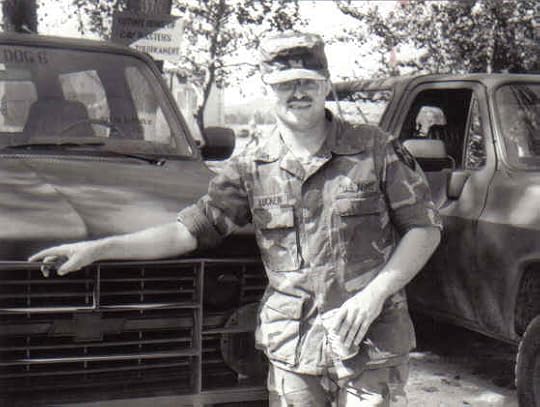 Tom at Camp Stanley
Tom at Camp StanleyIn January 1988, the 4th Squadron, 7th Cavalry Regiment, was reflagged as the 5th Squadron, 17th Cavalry Regiment. As part of the reorganization, Tom was reassigned first to Camp Stanley (about twenty miles northeast of Seoul) and later to Camp Mobile (about forty miles north of Seoul), where he served as the Training NCO (noncommissioned officer). With all these facilities being so close to Seoul, Tom managed to get tickets for the baseball games being played as part of the 1988 Olympics in Seoul. However, as the games drew closer, it became clear he wouldn’t be able to use them because his unit had to be ready in case North Korea tried to disrupt the games. Much to his dismay, he gave the tickets away.
In 1989, Tom was reassigned yet again, this time back to Troop Alpha at Camp Garry Owen to conduct ground scouting missions as he had when he first arrived in 1987. This time, though, he was a “track commander” in charge of his M113 APV. Things remained quiet until he reached the end of his tour in April 1990, although he continued patrolling the DMZ with his Troop during their rotational assignments up until the time he departed. For his next assignment, he was headed to a familiar place – the National Training Center (NTC) at Fort Irwin, California.
Tom arrived at NTC in April 1990, this time as an evaluator instead of the one being evaluated. His formal position was Operational Controller, or “OC”, as part of the Operations Group. As units rotated through NTC for training, Tom evaluated their performance and documented lessons learned. Then, in August 1990, Iraq invaded Kuwait, setting the stage for Operation Desert Storm and the ensuing Gulf War. Training at NTC in the Mohave Desert was ideally suited to preparing U.S. units to fight against the Iraqis and dislodge them from Kuwait. Thus, tactics taught focused on defeating the Iraqi army.
As U.S. units started to deploy to the Middle East in preparation for Desert Storm, Tom deployed to the theater operations center (TOC) in Saudi Arabia as part of an NTC contingent. Their mission was to update U.S. Army forces on the tactics necessary to defeat the Iraqis. Their tactics proved successful, as the U.S. led coalition launched its ground attack against the Iraqis on February 24, 1991, destroying the Iraqi Army in just four days. After the combat ended, Tom and the rest of the NTC team took the lessons learned back to NTC to refine and improve unit training and tactics.
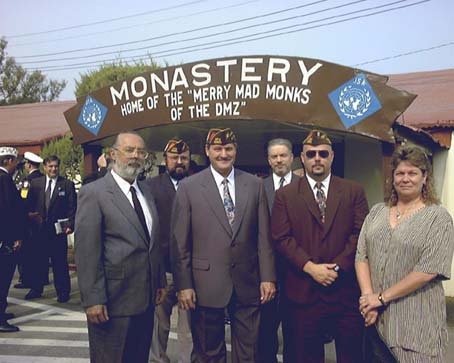 Members of VFW Post 9985 at Camp Casey (Tom is second from left, in back row)
Members of VFW Post 9985 at Camp Casey (Tom is second from left, in back row)Tom returned to Fort Irwin in March 1990. Looking ahead, he saw his end of obligated service coming up in July 1991. Believing a force drawdown after the war was inevitable and having family issues to deal with, he decided it was time to move on to the next chapter in his life. He came back to Illinois for a short while, but ended up returning to South Korea as a contractor helping train M1-A1 Abrams tank and Bradley fighting vehicle crews. He also joined VFW Post 9985 at Camp Casey, rising to the level of Post Commander. As a result, he was privileged to participate in several somber ceremonies at Panmunjom where North Korea returned the remains of U.S. servicemembers killed during the Korean War.
After nine years in Korea and with his father’s health failing, Tom decided it was time to return to the United States for good with his wife and four sons in the summer of 2000. They initially settled in Florissant, Missouri, and Tom took a job with Pitney Bowes as an electronics technician. Seven months later, Pitney Bowes offered Tom a promotion if he would move to Vandalia, Illinois, and with the blessing of his mother who said it would be better for Tom’s boys, Tom accepted the position.
Tom and his wife of twenty-nine years, Chun-soon, stayed in Vandalia with their family for fifteen years. Always drawn to his veteran friends, Tom was again active in the VFW, this time rising to the level of Post Commander for VFW Post 9770 in Brownstown, Illinois. As with the repatriation ceremonies in Korea, Tom found delivering military rights at the funerals of his comrades-in-arms the hardest part of his role, but also the most essential. He feels compelled to honor those who have served our country.
Voices to Veterans is proud to salute Sergeant Thomas Lucken, U.S. Army, for his years of dedicated service in the Army during the Cold War. In his eighteen-year combined active duty and contractor career, he spent thirteen-and-a-half years serving our country on the front lines of the Cold War overseas. His dedication and that of other servicemembers like him sent a strong message to any would-be adversary that our forces are ready anytime, anywhere. We thank Tom for his service and wish him fair winds and following seas.
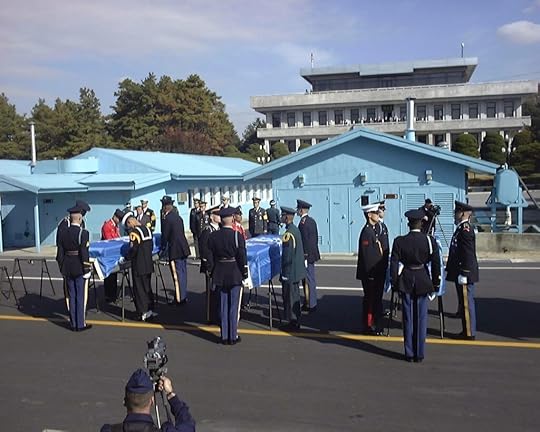 Remains Turnover Ceremony at Panmunjom
Remains Turnover Ceremony at Panmunjom
August 17, 2022
Chaplain Lavern W. Gardai, U.S. Army (Retired) – Serving God and Country
Chaplains in the military are a special breed. Not only do they assume the hardships of their own military service, including long family separations and deployments into combat zones, but they also try to lighten the burdens of the men and women they serve with by helping them carry their loads. Chaplain Lavern W. Gardai, U.S. Army (Retired), who served with the 1st Cavalry Division (Airmobile) in Vietnam and then went on to a distinguished twenty-eight-year Army career, knows these stresses all to well—he lived them firsthand. From ministering to the wounded, to surviving a deadly helicopter crash, he’s done it all. This is his story.
Vern was born in 1931 and raised in Saginaw, Michigan, a city of about 80,000 people located about 100 miles northwest of Detroit. His dad worked the night shift as a maintenance man at the Chevrolet Saginaw Grey Iron Foundry, while his mother stayed at home to raise Vern and his older brother and sister. Vern loved sports and played both football and baseball in high school. Although he wasn’t on the starting squads, he was a tough competitor and always got into the games to contribute.
Vern graduated from Saginaw High School in 1949 and enrolled at Alma College in Alma Michigan, located thirty-eight miles west of Saginaw. He thought about being a lawyer, but he also felt a very strong calling to serve God. To help pay his way through college, his father got him a job working at the foundry as a sweeper and driving an electric truck. In his “spare” time, he played football for Alma, helping the team win a small college championship. His friends also introduced him to Delores “Judy” Schafer and they began to date. Vern knew right away that he’d found the love of his life.
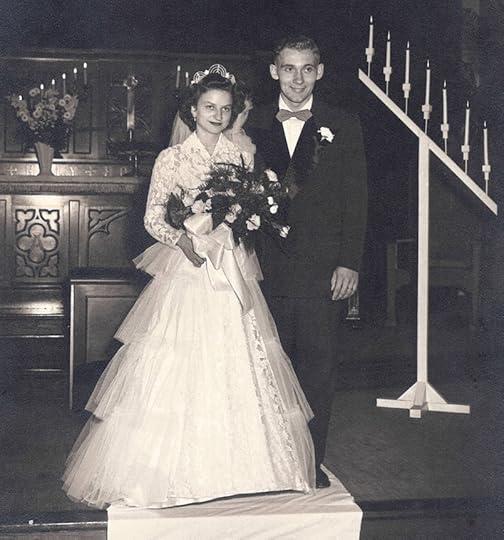 Vern and Judy’s wedding in 1952
Vern and Judy’s wedding in 1952In 1952, after completing two years at Alma College, Vern married Judy and transferred to Central Michigan University in Mount Pleasant, Michigan. His parents were so supportive of the marriage that they bought Vern and Judy a house trailer to help them begin their life together. They rented a mobile home lot in Mount Pleasant and set up their new house, but now Vern’s expenses were significantly greater and he could no longer work at the foundry. To make ends meet, he took a job as a police officer with the Mount Pleasant Police Department, working the night shift from 12:00 a.m. to 8:00 a.m. and then attending classes by day.
Despite all the changes in his life, Vern graduated from Central Michigan University in 1954 and enrolled in Trinity Lutheran Seminary at Capital University in Columbus, Ohio. This meant hitching the house trailer to Vern’s 1959 Mercury and hauling it 320 miles to a mobile home park in Columbus. Vern recalls being surprised at just how hilly the route was, putting a strain on his new car. He had to watch the engine’s temperature closely and stop periodically to let the engine cool and fill the radiator with water. They made it, though, and Vern began his studies to become a Lutheran minister in the fall of 1954.
As was the case in Mount Pleasant, Vern needed to find a job to fund his studies and support his family. This time, he took a part-time job at a Sears & Roebuck catalog store selling appliances and heating and cooling equipment. He was so successful, he outsold the full-time salesmen at the store. His boss told him that if he converted to full-time and stuck with it, he would be making $100,000 by the time he retired. Although that was enticing, Vern knew God had called him to the ministry, so he limited his work at the store to part-time and kept his focus on his studies. To make ends meet, he found additional work driving a bus for a Catholic church and preaching at local churches whenever they needed someone to fill in. Still, his focus remained his studies.
To help students like Vern decide what they wanted to do after being ordained, Trinity brought in speakers from various career fields to talk about their work. As Vern felt a particular calling to evangelism, he found two of the career fields particularly interesting. The first involved introducing Jewish people to Christianity, based upon the work of a minister at the Hebrew Christian Center in Pittsburgh, Pennsylvania. The other involved serving military members as a chaplain in the U.S. Armed Forces.
Neither of those opportunities presented themselves when it came time for Vern to graduate and be ordained in 1958. Instead, he accepted a position as a Lutheran minister in Manistee, Michigan, serving the St. Peters and Norwalk parishes. This time, they left the house trailer behind, selling it in Columbus and moving into the parsonage in Manistee. They stayed there for two-and-a-half years until an opportunity arose at the Hebrew Christian Center in Pittsburgh. After two-and-a-half years there, Vern and Judy decided it was time for a change.
The change was a big one. In 1963, Vern applied to the Lutheran Church to get its endorsement to become a military chaplain. Once the Church endorsed his candidacy, he applied to the U.S. Army and was accepted after passing his physical, beginning his twenty-eight-year career on active duty. His career started in July 1963 with three months of training at the U.S. Army Chaplain School, then located at Fort Hamilton in Brooklyn, New York. Most of the training consisted of classroom instruction learning how to be an Army officer and to minister to men and women of all faiths, with one week of the training spent out in the field.
Vern graduated from Chaplain School as a newly minted 1st Lieutenant (O-2). After taking leave in Saginaw to pick up Judy and their three children, he drove to his first duty station at Fort Benning, Georgia, where he was assigned to the 2nd Infantry Division, known as the Indianhead Division. About a month after reporting, he began working at the Harmony Church Barracks, where the Army conducted Basic Training for new recruits. His duties consisted of conducting Protestant worship services, weddings, baptisms, confirmations, and Bible studies. He also implemented a Bible contest, consisting of twenty-eight questions circulated to the troops to test their knowledge of the Bible. The contest included easy and medium-difficulty questions, with one tricky question designed to act as a tiebreaker. Since first prize included a full-day pass, fifteen dollars, and having Vern complete the winners KP (“Kitchen Police”) duties for a day, lots of soldiers participated. When the battalion’s First Sergeant (E-8), a senior enlisted soldier who did not have to do KP, won the contest, Vern did a half-day’s KP for the second-place winner. Lots of soldiers came by the mess hall to watch Vern washing pots and pans. The contest was a big hit and he would use it again later in his career.
In 1964, Vern participated in Exercise Long Thrust IX, a three-month exercise in Europe designed to demonstrate the U.S. capability to quickly reinforce NATO forces. After returning from the exercise, Vern transferred to the newly formed 11th Air Assault Division (Test), which was experimenting with using helicopters to quickly maneuver troops on the battlefield. This meant he had to learn to repel from ropes hanging from hovering helicopters, as well as to climb rope ladders from the ground back into the helicopters waiting above. As if that wasn’t enough, he also became parachute qualified, which he did by conducting five parachute jumps at Airborne School, so he could better relate to the experiences of the soldiers in his unit.
Throughout 1964 and into 1965, Vern participated in all the 11th Air Assault Division’s experimental maneuvers, including an eighty-day war game in the field against the veteran 82nd Airborne Division. The 11th Air Assault Division proved to be such a success that on July 1, 1965, it was redesignated as the 1st Cavalry Division (Airmobile). On July 28, 1965, President Lyndon B. Johnson ordered the division into the escalating war in Vietnam.
Because Judy and the kids were not permitted to live in Fort Benning housing while Vern went off to war, they had to find a rental house off post. This meant not only would Judy have to raise the kids on her own for the next year, but she would also have to do so in an unfamiliar neighborhood and while trying to put the family’s house in order. The move made Vern’s pending departure even more difficult than it already was.
After saying goodbye to his family, Vern deployed onboard the transport ship USNS Maurice Rose as part of the 2nd Battalion of the 3rd Brigade, 7th Cavalry Regiment, 1st Cavalry Division (Airmobile), led by Lieutenant Colonel Robert McDade. The ship sailed from Charleston, South Carolina, through the Panama Canal to Long Beach, California, where Vern got off the ship long enough to call Judy. The ship then began its long voyage across the Pacific Ocean to Vietnam, stopping briefly in Hawaii and then returning to Hawaii when a soldier’s appendix burst and he needed emergency treatment. As the ship continued, Vern held worship services and conducted baptisms and confirmations for the troops who were preparing themselves for what lay ahead. As if the thought of impending combat wasn’t stressful enough, the ship skirted a typhoon in the western Pacific before arriving at its destination, making the last few days at sea particularly uncomfortable.
On September 20, 1965, Vern and the rest of the 2nd Battalion landed in Qui Nhon, a coastal city in the Republic of South Vietnam about 600 miles northeast of Saigon. The battalion moved by helicopter fifty miles inland to its new base camp at An Khe in Vietnam’s Central Highlands. Although an advance party and an Engineering Battalion had prepared the site for the battalion’s arrival, much work remained to protect the camp from enemy attack. Vern was assigned a tent near the camp’s artillery unit, which fired rounds at all times of the day. While the artillery fire kept the enemy guessing, it also made getting a good night’s sleep difficult. Even more sleep-disturbing were the mortar rounds the enemy lobbed into the camp to keep the Americans on edge. To help protect himself from these attacks and absorb any stray shrapnel, Vern stacked sandbags all around his cot.
In November 1965, Vern’s 3rd Brigade was put to the test in the first major battle of the Vietnam War involving U.S. and North Vietnamese troops. On November 14, the 1st Battalion of the 3rd Brigade, under the command of Lieutenant Colonel Hal Moore, helicoptered to Landing Zone X-Ray in the Ia Drang Valley and engaged a significantly larger force of North Vietnamese regulars. Elements of Vern’s battalion joined in the battle, as did U.S. airpower and artillery, while Vern ministered to the wounded and dying soldiers who had been evacuated to the brigade’s forward aid station. The battle at Landing Zone X-Ray raged for three days, ending with Lieutenant Colonel Moore’s forces controlling the battlefield.
Although the 1st Battalion’s fight ended on November 17, the 2nd Battalion’s fight was just beginning. Having been choppered into the fight at Landing Zone X-Ray, instead of flying out as Lieutenant Colonel Hal Moore’s battalion did, the 2nd Battalion marched out in a column headed for Landing Zone Albany. Seeing the 2nd Battalion stretched out in a long line through the jungle, Vietnamese forces ambushed the unsuspecting Americans. Unable to form into a defensive position or call in air strikes or artillery, the 2nd Battalion suffered significant casualties before the North Vietnamese withdrew during the night. One of the men killed in the ambush was Vern’s nineteen-year-old Chaplain’s Assistant, who had become like a brother to Vern. They had been working together since Vern’s initial assignment to the Harmony Church Barracks. In the end, 234 U.S. soldiers were killed and more than 250 were wounded in the engagements at Landing Zone X-ray and Landing Zone Albany, while the North Vietnamese suffered well over 1,000 casualties.
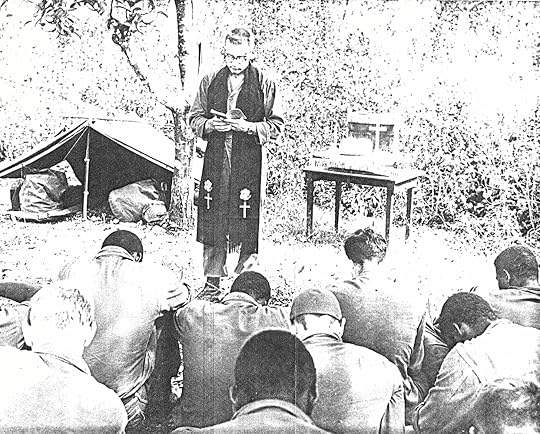 Chaplain Gardai holding a service in the field in Vietnam
Chaplain Gardai holding a service in the field in VietnamVern performed a host of Chaplain’s duties throughout his tour in Vietnam. In addition to helping lead men to the Church and providing counsel to young soldiers far from their families and support systems, he led worship services before each mission. These services carried special significance since the men attending never knew if they would make it back alive. Typically, units would spend ten days on a mission and then return to the base camp at An Khe for ten days rest before starting the cycle over again. Vern ministered to the men while they were back in camp and routinely visited them when they stood guard duty around the perimeter of the camp, traveling between posts on a scooter.
When the battalion went on a mission, Vern deployed with it as part of the headquarters company. After the battalion’s maneuver companies completed their search and destroy missions deeper in the field, Vern visited these companies by helicopter to conduct worship services for the men. He always wore a flak jacket in the helicopter on his way to and from these visits and would toss it on the ground when exiting the helicopter. When it was time to depart, he’d retrieve the flak jacket and put it on for the ride back. That practice changed after he picked up his flak jacket for one such return trip and found a big black poisonous scorpion hiding beneath it. Clearly, enemy soldiers weren’t the only things he had to worry about.
On another mission, he went with a patrol looking for a downed aircraft that had crashed somewhere in the vicinity of the camp. They found the wreckage after four or five hours of wandering through the tall elephant grass with bad maps, only to learn the site was just an hour from the camp. Unfortunately, the pilot did not survive.
To stay connected with the soldiers in his battalion, Vern made an effort to walk in their shoes. Although he did not carry a weapon, he knew how to fire all the weapons they employed. When he went with the soldiers into the field, he carried a backpack, a poncho, an entrenching tool, a pup tent, and c-rations, just like they did. In the two ammunition pouches on his belt, he carried “spiritual ammunition” – a small bottle of wine and wafers to give communion and hymn books and Bible verses to distribute whenever the opportunity presented itself.
Vern’s tent was always open to any soldier needing someone to talk to and he routinely flew to visit platoons camped in the field. He also visited wounded soldiers being treated in field hospitals. When a soldier died of his wounds, Vern wrote a letter to his family to try to comfort them in their grief. Although all such letters were difficult to write, none was more so than the ones he wrote to the parents and fiancée of his Chaplain’s Assistant killed at Ia Drang.
On the night before the battalion was to deploy in support of operations around Bong Son, Vern found a distraught sergeant reading a letter in the chapel. Vern spoke to the sergeant and learned he had previously killed a man with a knife in hand-to-hand combat in the Dominican Republic and was concerned he might have to kill again in battle. Vern comforted the sergeant and spoke to him about forgiveness. The sergeant then left to prepare for their 4:00 a.m. departure. The next morning when it came time for Vern to board a C-123 transport plane, the executive officer approached him and said the plane just ahead of Vern’s had crashed and he needed Vern to accompany the rescue efforts at the crash site. When Vern arrived, he was able to identify one of the victims—the sergeant he had spoken to the night before. The sergeant would never have to kill again.
One month before Vern was scheduled to return to the United States, a soldier clearing elephant grass from the perimeter of the camp with a machete stepped into a hole and fell, impaling himself with the machete. He staggered to the vicinity of Vern’s tent, where Vern heard him yelling “help me, help me”. Vern and a doctor responded, and together they eased the machete out of the man’s side. He was seriously injured, though, and needed to be medevac’d to the surgical hospital in Pleiku. Although night had set in and the monsoon rains were upon them, a CH-47 Chinook helicopter pilot agreed to make the flight. Vern and the doctor placed the soldier on a stretcher and lifted him into the waiting helicopter. They then climbed aboard to accompany the soldier to the hospital.
The chopper took off but made it no higher than 200 feet before it came crashing back to earth. Vern remembers being thrown about, his helmet flying off, and the smell of hot oil permeating the air once the helicopter came to rest on its side. Afraid the helicopter would soon burst into flames and he would be burned alive, he prayed “Lord, help me.” Then he heard a voice and saw a red light coming his way. He crawled in the direction of his rescuers, only to realize his leg must be broken. When he emerged from the wreckage, he was put in a Jeep and given pain killers. He watched as rescuers brought the pilot and copilot out through the helicopter’s broken windshield. Both the pilot and copilot survived, but a sergeant and the soldier injured by the machete died in the crash.
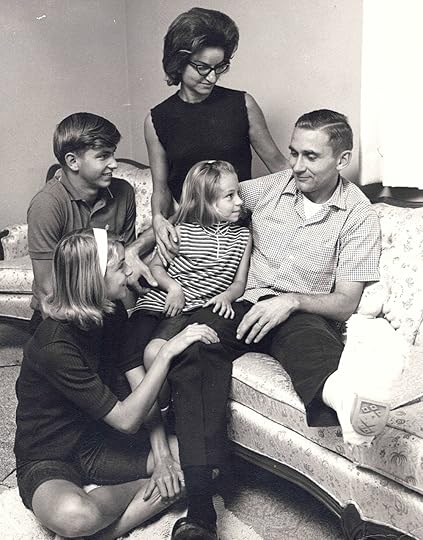 Vern reuniting with his family after returning from Vietnam
Vern reuniting with his family after returning from VietnamAn ambulance transported Vern to the hospital in Pleiku. On July 25, he was evacuated to a hospital in Tokyo via the Philippines, where he was treated for a broken leg and a compression fracture in his spine. He still suffers from back pain resulting from the crash, as well as from exposure to Agent Orange, and has had a total of eleven operations stemming from his service in Vietnam. After ten days in the hospital in Japan, he returned to the United States and reunited with Judy and his children at Fort Benning.
With his war over and now a Captain (O-3), Vern was assigned to the 1st Battalion, 60th Artillery (HERC), which operated a Nike Hercules air defense missile site in Gary, Indiana. He spent two-and-a-half years there and was called on forty-five times to deliver death notices to families in the Chicago area when local soldiers were killed in Vietnam. The duty made him feel like “the angel of death”. He also experienced nightmares from things he’d seen and experienced in Vietnam. It was several years before the nightmares finally stopped.
In 1968, Vern transferred to Heidelberg, Germany. This tour was particularly memorable for Vern because he attended a USAA sponsored chaplains retreat in Israel. Vern paid for Judy, so she got to go too. Vern would visit the Holy Land a total of three times over the next few years, inspiring him for the rest of his life. He also re-instituted the Bible contest he previously employed at Fort Benning and orchestrated two successful retreats attended by hundreds of soldiers on Sex, Love, and Marriage and Taking a Trip with God Instead of Drugs.
In 1972, Vern returned to the United States for an assignment with the 1st Cavalry Division at Fort Hood, Texas. This tour was particularly important for Judy because it gave her the opportunity to complete her master’s degree in Criminal Justice from American Technological University. As Vern’s tour at Fort Hood drew to a close in 1975, Vern thought he would be returning to civilian life when he learned his promotion to major (O-4) was temporary. He was okay with that outcome, believing the Lord would send him where he needed to be. Then, to his surprise, a special promotion board selected him for permanent promotion to major and his Army career continued.
After promoting to major in 1975, Vern was assigned to U.S. Support Activity – Iran, which at the time was still friendly to the United States. As the only Army chaplain in Iran, Vern and his Chaplain’s Assistant visited U.S. military detachments training the Iranian armed forces to use U.S. weapons systems purchased through U.S. military assistance programs. Their travels took them to fourteen cities and twenty-two team houses across Iran. Since his wife and youngest daughter accompanied him to Iran, he traveled with them to visit the historic cities of ancient Persia mentioned in the Bible. Again surprising Vern, he learned he was selected for promotion to Lieutenant Colonel (O-5) while he was in Iran. The U.S. embassy in Tehran fell to Iranian revolutionaries in 1979, one year after Vern and his family departed.
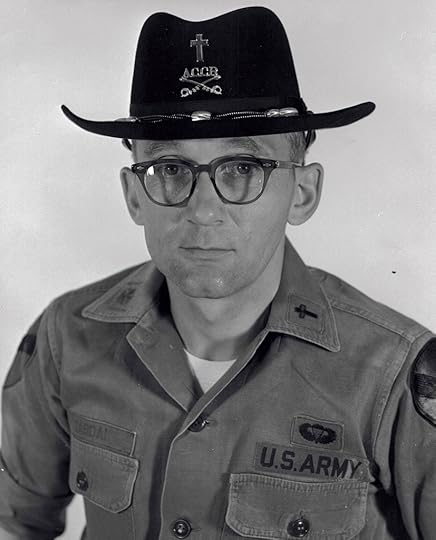 Chaplain Gardai at Fort Hood, Texas
Chaplain Gardai at Fort Hood, TexasAfter detaching from Support Activity – Iran, Vern had assignments in Aschaffenburg and Mainz, Germany, Fort Hood, Texas, and Zweibrucken, Germany. In 1987, he took his final set of orders to Fort Sill, Oklahoma, where he served as the lead chaplain for the Basic Training Brigade. He retired in July 1991, having served twenty-eight years on active duty. He was awarded numerous decorations for his service, including the Bronze Star Medal with Oak Leaf Cluster, the Meritorious Service Medal with Oak Leaf Cluster, the Army Commendation Medal with Oak Leaf Cluster, the Presidential Unit Citation-Army, the Vietnam Service Medal with three bronze stars, the Republic of Vietnam Campaign Medal, the Air Medal, the National Defense Service Medal with service star, the Army Service Ribbon, three Overseas Service Ribbons and two Overseas Service Bars, and the Parachutist Badge.
With their Army years behind them, Vern and Judy traveled in Europe before purchasing a home in Colorado Springs, Colorado, where they lived for eighteen years. Vern particularly enjoyed being able to play golf year-round and helping local churches by filling in when they needed a minister. He and Judy also continued their travels in Europe until Judy became ill and could no longer travel. Vern states Judy “joyfully went to heaven” in 2014 and describes the sixty-two years they spent married together as “a taste of heaven”.
Vern now enjoys keeping up with all three of his children and their families. In fact, he lived with his oldest daughter, Lorna, in Texas, before moving to Maryville, Tennessee, where he currently lives with his youngest daughter, Christine. Perry, who followed in his father’s footsteps by graduating from Central Michigan University, is close by, having retired in Toledo, Ohio. Besides family, Vern hosts a veterans’ coffee once a week at the Vienna Coffee Shop in downtown Maryville, giving veterans the opportunity to drink a cup of coffee together and share their military experiences. Each week between three and ten veterans attend.
Voices to Veterans is proud to salute Chaplain Lavern W. Gardai, U.S. Army (Retired), for his twenty-eight years of distinguished service to our country. His selfless service during the Vietnam War brought comfort to countless soldiers going into harm’s way, and his faith in God brought comfort and compassion to our soldiers when they needed it most. For twenty-eight years, he was on call day and night to serve our soldiers. For that, we are eternally grateful. We wish him fair winds and following seas.
 Vern Gardai
Vern Gardai
July 21, 2022
Specialist Ashley (Pullen) Hawkins, U.S. Army (Retired) – “V” for Valor in Iraq
Everyone faces adversity in life. How an individual deals with that adversity determines the course their life will follow. Specialist Ashley Hawkins, U.S. Army (Retired), has dealt with more than her share of adversity, yet she’s never let it define her. Instead, she confronts it head on and overcomes it, always looking toward a better future. This unwavering determination resulted in her being the first female soldier in U.S. history to be awarded the Bronze Star with a “V” for valor in combat. This is her story.
Ashley was born in 1984 in Danville, Kentucky, a small town located about thirty-five miles southwest of Lexington. To say she had a tumultuous childhood would be an understatement. Her parents were married in 1983 and were very young – her dad was twenty and her mom nineteen. Her mom brought a son from a previous relationship to the marriage and her dad adopted him. Ashley was born a year later, completing the family.
Ashley’s parents lived paycheck to paycheck. Her father quit school at the beginning of seventh grade, making it difficult for him to find work or earn enough to do more than scrape by. As a result, the family lived in a rent subsidized (Section 8) apartment in a poor section of town.
Wanting to provide a better life for her children, Ashley’s mother joined the Navy when Ashley was five. While Ashley’s mom attended boot camp in Florida and follow-on Aviation Electrician’s Mate school in Tennessee, Ashley’s father stayed at home in Danville and took care of the kids. When Ashley’s mother finally transferred to her first permanent duty assignment in Norfolk, Virginia, Ashley’s father moved the family to Norfolk so the family could be together again.
Unfortunately, Ashley’s mother and father began to have problems and split up in November 1990 when Ashley was not quite seven. Her dad moved back to Kentucky and her parents were divorced in May 1991. Tragedy struck two months later when Ashley’s father was seriously injured while working on a railroad track in July 1991. He was in the hospital for two months and it was nine months before he could walk again. Once he was back on his feet, Ashley moved to Kentucky to live with him while her brother stayed with her mother. Each year thereafter, the two kids rotated between their mother’s house in Virginia and later Florida, and their father’s house in Kentucky. That meant Ashley had to change schools every year growing up, never able to put down roots. It also meant Ashley only saw her brother on holidays when overlap in their back-and-forth travel schedules allowed.
A degree of stability came when Ashley turned fourteen. Both her parents had remarried and Ashley went to live permanently with her mother and new stepfather, who now lived in Hardin, Kentucky. For the first time in her life, Ashley attended the same school – Central Hardin High School – for four years in a row. This allowed her to excel in her studies and to participate in extracurricular activities like choir, cheerleading, and Jr. ROTC (which would prove significant down the road). She also worked every day after school, beginning by caring for a neighbor’s young boys and progressing to waitressing at a steakhouse and two local pizza parlors. Despite this busy schedule, Ashley still had time for a boyfriend. She started dating him her freshman year and continued to date him all through high school.
During Ashley’s senior year, she decided to do something to change the trajectory of her life. She wanted to see more of the world than just Kentucky and she did not want to live the life her parents had. Determined to make her life better, she enlisted in the Kentucky Army National Guard on December 17, 2001. Because she was only seventeen, her parents had to give their written permission, which they did. From that moment on, Ashley was a member of the Kentucky Army National Guard.
Although she was still in high school, Ashley drilled one weekend each month starting in January 2002 with the 940th Military Police Company. This meant she had to drive almost eighty miles each way to the armory in Lexington, Kentucky, located in the center of the state. The drive was worth it, though, because she earned $200 each month for participating in the drill weekends. Drilling also gave her the chance to meet the soldiers she would be working with once she completed her initial Army training later in the year.
Ashley graduated from Central Hardin High School with an “A” average in June 2002, just missing the honor roll by a fraction of a point. In September, she reported to Fort Leonard Wood in Missouri for Basic Training, followed immediately by Military Police training at the same installation. She found Basic Training tolerable, although the physical component proved difficult because she was only five-feet, two-inches tall, and while she was very healthy, she was not used to the physical training she soon found herself immersed in. She worked hard at it, though, and by the end of Basic Training, she had the most improved score in her platoon on the physical fitness test.
After training for seventeen weeks at Fort Leonard Wood, Ashley graduated with her new Military Police MOS (military occupational specialty) on December 19, 2002. Because she participated in Jr. ROTC in high school, she was already a Private First Class (E-3), giving her a substantial pay advantage over her fellow graduates, most of whom were still Privates (E-1). She didn’t have time to celebrate, though, because she had enrolled at the University of Kentucky using her GI Bill and had to move to Lexington over the holidays to start classes in January 2003. She also had to return to weekend drilling with her unit, the 940th Military Police Company.
Ashley’s weekend duties with her unit centered around classroom training involving military law enforcement and providing security for major events like the Kentucky Derby. Two weeks each year, the unit conducted unit-level training at the Wendell H. Ford Regional Training Center, located in western Kentucky near Bowling Green. In addition to operating their Humvees (High Mobility Multipurpose Wheeled Vehicles) in the field and conducting mock engagements, they completed their annual firearms training and physical fitness test. In short, the two weeks at Wendell H. Ford were chock-full of training events, allowing the unit to put everything it learned during the weekend drills into practice in the field.
Because she had sufficient time in grade, Ashley promoted to Specialist (E-4) in the spring of 2003. Things progressed on the civilian side of her life, as well. Her foray into college did not go as planned because she felt burnt out after working her way through high school and then completing her seventeen weeks of Army training. She also got engaged to her high school boyfriend in the spring of 2003 and they were married in June of 2004. With Ashley no longer in college receiving the GI Bill, living in Lexington proved too expensive. So, in September 2004, Ashley and her husband moved about two hours away to Metcalfe County, Kentucky, where the cost of living was more affordable.
Ashley’s September 2004 drill weekend at the armory in Lexington fell right in the middle of her move to Metcalfe County. During the drill weekend, she heard a sister unit, the 617th Military Police Company, was deploying to Iraq and that it needed a Specialist (E-4) to deploy with it as one of their Specialists could not go. Ashley suspected she might be one of the people being considered because she had all the necessary qualifications and her maiden name, Ammons, made her appear at the top of the alphabetical list (the Army had not yet changed her name to her married name, Ashley Pullen). To find out for sure, she asked her sergeant if she would be “voluntold” to deploy. He told her no, so she drove back to Metcalfe County to finish moving into her new apartment.
The next day, September 13, 2004, Ashley waited outside a Walmart while her husband applied for a job. At about 1:00 p.m., her sergeant called and told her she needed to get her gear and report to the armory in Richmond, Kentucky, by Wednesday morning because she had been selected to deploy with the 617th Military Police Company. That left her only thirty-six hours to gather her gear, most of which was packed away for her move, put her affairs in order, and report ready for extended duty in Iraq. Although Ashley wished she’d been told about being selected on Sunday so she’d have at least a few more hours to prepare, she gathered what gear she could find and reported as ordered on Wednesday morning, September 15.
Before the 617th Military Police Company could deploy, it had to complete its two-weeks of field training at the Wendell H. Ford Regional Training Center. Ashley joined the unit in time to participate and was assigned to the 4th platoon, 3rd squad. After completing field training, the unit reported to Fort McCoy in Wisconsin around October 5 for mobilization training. That training lasted until just before Thanksgiving, when the unit boarded a flight headed for Camp Arifjan in Kuwait, which served as the jumping off point for Army units deploying into Iraq.
Ashley and the 617th Military Police Company flew into Baghdad and were in place by Thanksgiving at Camp Liberty, a large U.S. and Coalition military base located northeast of Baghdad International Airport. The unit commenced operations immediately, providing route security for convoys traveling between, and bringing supplies to, various military facilities in the area. The convoy routes were hazardous, with convoy vehicles often coming under attack from Iraqi insurgent forces or incurring damage from Improvised Explosive Devices (IEDs) placed along the highways. Ashley’s job, together with the rest of the members of her squad, was to patrol the roads in advance of the convoys to make sure they were safe for the convoys to pass. This meant looking for anything unusual – road construction, animal carcasses, or other signals – that might indicate the presence of an IED or a potential ambush. They also established checkpoints to inspect passing vehicles for weapons or possible insurgents preparing to attack the convoys.
 Ashley standing on her Humvee in Iraq
Ashley standing on her Humvee in IraqAs route security operations began, Ashley transferred to the 4th platoon, 2nd squad (call sign “Raven 42”) to replace an individual who had to be evacuated from Iraq. Ashley drove one of the three Humvees assigned to her squad. This meant she had to maintain the vehicle in fighting condition at all times. If her vehicle needed an oil change at the end of the day, she couldn’t hit the rack until the job was finished. Tires needed to be checked and radios maintained, supplies needed to be stowed, and the Humvee’s .50 caliber machine gun in the turret atop the vehicle had to be fully operational. All of this proved a challenge in the unforgiving environment of the Iraqi desert. But the squad could not afford to have a Humvee fail on a mission because that would put the crew at risk, so Ashley took her responsibilities seriously.
Providing route security proved challenging from the start. Around January 18, the squad was warned of a potential ambush of a convoy, but it could not locate any insurgents. A week later after a similar warning, the squad secured two prisoners. Then, on February 2 at about 7:15 a.m., Ashley’s Humvee hit an IED just after departing Camp Liberty. The bomb detonated behind the driver’s seat, damaging the vehicle and taking it out of action. Unbelievably, no one in the Humvee was injured, although Ashley found a small splinter of shrapnel in her hand the next day, which she removed herself. Nine days after the IED attack, Ashley turned twenty-one.
Ashley received a brand-new Humvee to replace her disabled vehicle during the first week of March 2005. It took time to set up the vehicle, as Ashley’s squad leader, Staff Sergeant Timothy Nein, wanted all three of the squad’s Humvees configured identically so the crews could operate from any of them and find what they needed quickly in an emergency. Staff Sergeant Nein’s foresight would prove crucial in the coming weeks.
In mid-March, the 4th platoon, 2nd squad was dispatched to Camp Cuervo, a base camp located about six miles southeast of Sadr City on the outskirts of Baghdad. The squad’s mission was to provide security for convoys heading to and from the camp. Insurgents were active in the area, as the squad observed first-hand when an IED disabled a convoy truck on March 18. Ashley’s squad reported to the scene and secured the area until the truck and the supplies it carried were hauled away twenty-six hours later.
Ashley’s squad did not have an assignment on March 19 given their twenty-six-hour mission the day before. However, first thing in the morning on March 20, they were back on the roads again, this time in the vicinity of the town of Salman Pak, located about thirty miles south of Baghdad. As was the standard practice, the three Raven 42 Humvees got an early start to do an initial sweep of the roads. The squad then stopped long enough for another squad to deliver them breakfast and take their place on the road while they ate. As they finished their breakfast, they saw a large truck convoy file past, so they mounted their Humvees and fell in behind the convoy. Ashley drove the second of the three Humvees.
After about ten minutes, they noticed the trucks up ahead driving erratically. With the vehicle noise, the windows up, and their earplugs in, they couldn’t hear anything, but their experience told them the convoy was under attack. Immediately, the three Raven 42 Humvees went into action, speeding up and passing the convoy trucks on the right until they came to an access road running perpendicular to the highway. Staff Sergeant Nein and his lead vehicle turned onto the access road and Ashley followed about fifty feet behind, the turret gunners in both Humvees now exchanging fire with insurgent fighters. After they’d driven about 300 yards down the access road, Ashley saw a rocket-propelled grenade (RPG) hit Staff Sergeant Nein’s vehicle in the rear passenger door. Although the explosion didn’t shatter the door’s window, it did push the Humvee to the left and the turret gunner went down. Moments later, the gunner was back in the turret firing again—a good sign.
At this point everyone exited Staff Sergeant Nein’s and Ashley’s Humvees, except the turret gunners, who continued firing at insurgent positions. As bullets pinged off the Humvees and grenades exploded around them, the crews of the two lead vehicles returned fire with their M4 carbines. Ashley moved behind her vehicle and fired a magazine of suppressing fire in the direction of the insurgents engaging her squad from the right. As she did, she saw Staff Sergeant Nein run to a tall berm along the left side of the road and throw a grenade behind it, alerting Ashley to the attack from that side of the road. After Ashley fired about half the rounds in her second magazine, she heard a call for help coming over her vehicle’s radio from the third Humvee. She looked back and saw it had stopped just after turning onto the access road and was about 300 yards behind her vehicle. As she moved back to the driver’s side of her Humvee and began to talk on the radio to the third vehicle, Sergeant Leigh Ann Hester, also from Ashley’s Humvee, loaded up with grenades and magazines for her M4.
Ashley recognized the voice on the radio—it was the squad’s medic, Sergeant Jason Mike. He said everyone in the third vehicle was down and they needed help. Ashley got out of her Humvee and shut the door just as Staff Sergeant Nein approached. He asked her what her situation was and she reported the third vehicle’s predicament. His direction was simple: “Okay, take care of it.” That was all Ashley needed to hear. She climbed into her vehicle, did a J-turn, and drove back toward vehicle three. She stopped about 100 yards from the vehicle and positioned her Humvee so the turret gunner could continue to return fire. She then got out of the vehicle and ran the rest of the way to Humvee number three, all the time with the firefight going on around her.
When Ashley arrived, she found the vehicle’s turret gunner, Specialist William Haynes, still firing. She asked him if he was okay and he gave her a bloody thumbs-up, having been shot in the hand. Sergeant Mike was returning fire in the direction of a concrete building Ashley hadn’t noticed before, using a rifle he’d picked up. Ashley found another soldier, Specialist Bryan Mack, shot in the shoulder and she helped apply pressure to his wound before moving to the front of the vehicle, where she found the vehicle’s team leader, Sergeant Joseph Rivera, lying on the ground in a pool of blood and mud. She looked for his wound and found he’d been shot in the abdomen, the bullet having entered just below his body armor. She pulled out her bandage and applied pressure to the wound, all the time with Sergeant Rivera telling her to leave him and take care of his men.
Believing there had to be an exit wound, Ashley checked and found Sergeant Rivera bleeding out of his back. That meant she needed more bandages, but none were available where she was. Leaving her rifle with Sergeant Rivera, she ran back down the road to her Humvee, all the time exposed to enemy fire. After opening some ammunition cannisters for her turret gunner, she grabbed a first aid kit and ran the 100 yards between the two Humvees for the third time. As she attended to Sergeant Rivera, she heard “back blast area clear”. She looked up and saw Sergeant Mike getting ready to fire an AT4 anti-tank rocket at the concrete building, so she covered the wounded team leader with her body to protect him from the blast. The blowback from the weapon’s firing threw her off Sergeant Rivera but neither soldier was injured.
Ashley returned to bandaging Sergeant Rivera’s wounds and applying pressure to stop the bleeding. After two or three minutes, a Humvee from another squad arrived and a sergeant from the vehicle asked Ashley what she needed. She told him she needed help getting the wounded soldiers to the medevac site as Sergeant Rivera, in particular, was seriously wounded. Ashley and the sergeant loaded everyone into the Humvee and they drove to the medevac site, where the wounded were transferred to a waiting helicopter. Ashley told the aircrew she’d delivered her squad mates alive and she expected everyone to stay that way. All would survive.
Ashley’s work was not yet finished. Immediately after the medevac helicopter departed, Ashley returned to the ambush site to rejoin the remaining members of her squad. When she arrived, the action had largely concluded, with the insurgents having suffered a major defeat. Led by the efforts of Staff Sergeant Nein and Sergeant Leigh Ann Hester, twenty-four insurgents were killed, nine were wounded, and one was captured. In addition, the squad captured a cache of AK-47s, RPGs, machine guns, hand grenades, and ammunition. All of this was loaded into Ashley’s Humvee, which she then drove back to her home base at Camp Liberty, about four hours away.
After the engagement, Ashley called home to tell her parents she was okay. It was good she did because the news of the firefight had already reached Kentucky and her parents were concerned. Then, after about a week-and-a-half break that included interviews with the press to talk about the battle, she and the remaining members of the 4th squad, 2nd platoon, were back on the roads conducting route security.
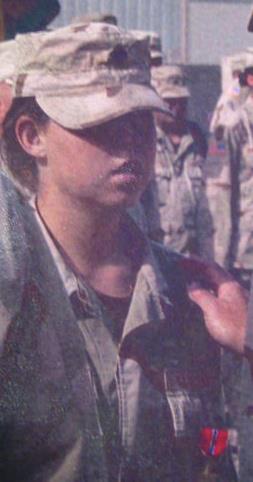 Ashley (Pullen) Hawkins being awarded the Bronze Star with “V” for valor
Ashley (Pullen) Hawkins being awarded the Bronze Star with “V” for valorAs a result of the thirty-minute engagement on March 20, Staff Sergeant Timothy Nein, Sergeant Jason Mike, and Sergeant Leigh Ann Hester were awarded the Silver Star (Staff Sergeant Nein’s award was later upgraded to the Distinguished Service Cross). In addition, Specialist Casey Cooper, Specialist William Haynes, and Ashley received Bronze Stars with “V” for valor. Significantly, Sergeant Hester’s and Ashley’s awards marked the first time female soldiers had ever received these awards for valor in actual combat.
Ashley barely made it through the June 16th award ceremony. She had somehow contracted a virus that made her so pale the three-star general pinning on her award told her to go lay down right away. She went to the base hospital, where they found her blood pressure had dipped to 65 over 30. She was hospitalized for a week before she could rejoin her unit.
In late June 2005, the members of Raven 42 were sent to Fort Leonard Wood in Missouri for a brief press tour. While they were gone, their Humvees were repainted and all Raven references removed. When they returned to Iraq on July 6, even their Raven 42 call sign was changed. These changes were necessary because of reports the insurgents had put a price on their heads after the battle of March 20.
The squad continued providing route security until the end of August 2005, when it was pulled off the line and assigned other duties. Then, on October 26, 2005, the squad and the rest of the 617th Military Police Company departed Iraq, having successfully completed its one-year deployment.
Once home in Kentucky, members of the unit were given six months off, but Ashley noticed something was wrong. With the help of her mother, Ashley registered with the Veterans Administration, and in December 2005, she was diagnosed with post-traumatic stress disorder (PTSD). After a divorce and a bureaucratic struggle that took several years to resolve, Ashley was medically retired from the Army in March 2013.
Ashley now lives in Harrodsburg, Kentucky, with her husband, Thomas Hawkins, and their family of five children. She actively supports the veteran community and recently participated in an Honor Flight to Washington, DC. And, displaying the toughness and resilience she’s shown all her life, she is currently battling breast cancer and is nearing completion of her treatment. The ordeals she’s been through have taught her not to take life for granted. She willingly talks about her experiences because she knows if she doesn’t, they will fester inside her. She has chosen not to let that happen, instead making the most of every day she is given.
Voices to Veterans is proud to salute Specialist Ashley (Pullen) Hawkins for her wartime service in Iraq with the Kentucky Army National Guard. Ashley displayed great courage in combat, not only engaging a determined enemy, but also helping save the lives of her fellow soldiers. Although we can never repay her for the sacrifices she made, we can truly thank her for her dedicated service to our country. We wish her fair winds and following seas.
June 15, 2022
Sergeant Ron Haeberle, U.S. Army – A Photo of Future Hope
Photographs are like time capsules, forever freezing a moment in time. They provide us with a window into the past, documenting our history in a way the written word cannot. Yet for Sergeant Ron Haeberle, U.S. Army, a photograph he took on March 16, 1968, did more than just look back in time. It foretold the future—a future built on courage and survival and shining as a beacon of hope to all who see and understand it. Now, over fifty years after Ron’s Nikon camera captured the image, it serves as an inspiration for Ron in every aspect of his life. This is Ron’s story.
Ron was born and raised in Northeastern Ohio. His father worked as a superintendent for the Republic Steel Corporation and his mother worked as a secretary in the Fairview Park, Ohio, public schools. Ron and his sister attended Fairview Park High School, where Ron played football and ran track. He graduated in the spring of 1960 and began to work for the Fairview Park School System to save money for college. In the fall of 1962, he enrolled at Ohio University in Athens, Ohio, majoring in photography and aspiring to become a photojournalist.
During Ron’s fourth year at Ohio University, he changed his status to part-time for the spring semester of 1966. With U.S. involvement in the Vietnam War escalating daily, the university’s Registrar’s Office reported the change in Ron’s enrollment status to the federal government. The result was Ron received a draft notice, directing him to report immediately for induction into the military. Ron asked for a three-month delay so he could complete his degree, but with the war’s insatiable appetite for young men, his request was denied.
In April 1966, Ron drove home from Athens and, after a short visit with his family, reported as directed to the Armed Forces Examining and Entrance Station in downtown Cleveland. There he passed his physical and together with the other draftees, was officially inducted into the Army. He and the other draftees then marched in a makeshift formation to the Terminal Tower on Public Square, with onlookers gawking all the way. At the Terminal Tower, they boarded a Rapid Transit train to Cleveland Hopkins Airport for a flight to Atlanta. Once they arrived in Atlanta, a waiting bus drove them to Fort Benning, Georgia, for Army Basic Training.
In-processing began immediately with the new arrivals getting haircuts and uniforms and receiving their barracks and training company assignments. As Ron expected, Basic Training included a significant physical component, but he did not find it difficult because he had been an athlete in high school and stayed in shape throughout college. In fact, his athletic prowess paid off more than once because it allowed him to win various contests within the company, the prize being he didn’t have to stand “KP” (kitchen police) duty, washing pots and pans and doing other similar chores in the chow hall.
After eight weeks, Ron graduated from Basic Training. He followed graduation with a short leave period at home in Northeast Ohio, then he reported to Fort Ord in Monterey, California, for Advanced Individual Training (AIT) to become a mortarman. In the eight-week course at Fort Ord, Ron became proficient at firing the M29 81-millimeter mortar, which could fire a high-explosive mortar round at a target located over two miles away. Training began with the basics, with the novice mortar crews learning never to put a foot under the baseplate of their mortar to try to stabilize it or the concussion would crush their foot when the mortar was fired. Once proficient, the soldiers participated in search and destroy mission training, where the trainees learned to seek out and engage enemy units.
Ron also learned to fire a .50-caliber machine gun. Interestingly, a chain linking the barrel of the gun to the firing platform prevented the barrel from elevating above a certain level. When the trainees asked why the chain was necessary, the instructors pointed to California’s Highway 1 off in the distance and said if the barrel was elevated too high, rounds from the machine gun might impact cars on the highway. After looking up and seeing the vehicles driving along the highway, Ron was amazed the weapon was being live-fired in such a confined training area.
When it came time for AIT graduation in the late summer of 1966, the graduating privates lined up to receive orders for their follow-on tours. Although many soldiers received orders to Vietnam, Ron did not. Instead, he was assigned as a mortarman for the 11th Infantry Brigade, which had just reactivated on July 1, 1966, at Schofield Barracks in Hawaii. Ron reported to Schofield Barracks, located about twenty-two miles northwest of Honolulu, in September 1966.
After Ron arrived, he began exploring the post and meeting the soldiers he would be working with. Harkening back to his desire to become a photojournalist, he took pictures of his new comrades in arms and of the barracks they lived in, documenting their daily lives. About a week into his assignment, the brigade commander saw him taking pictures and asked what he was doing. Ron told him about his background at Ohio University and that he had majored in photography.
The conversation gave the brigade commander an idea. As the 11th Infantry Brigade had just recently reactivated, he could use someone like Ron to document the brigade’s activities and help provide publicity for the brigade’s accomplishments. He asked Ron for his name and then strode away. A few days later, Ron received a notice – he was being transferred to headquarters to be a one-man public information office for the brigade. He would never fire a mortar again.
Ron loved his assignment in the newly created brigade public information office. Not only did it mean working at brigade headquarters, but he also was assigned his own jeep and had unrestricted use of the base photo lab. His official responsibilities included taking pictures of the soldiers in action during brigade training and documenting other milestones and events like promotion and award ceremonies. After developing the pictures, Ron added captions to the photographs for publication in the brigade newspaper. He also sent news releases and photos of individual soldiers to the newspapers in their hometowns to keep their families and communities apprised of their favorite sons’ accomplishments.
Ron took full advantage during his off-duty hours of living in Hawaii. Oahu was not nearly as developed as it is today and there were many things to explore. Ron tried surfing on Waikiki Beach, hiked around Diamond Head, and tried everything the island had to offer. He particularly enjoyed scuba diving, although on one occasion at Hanauma Bay things almost turned out badly. While diving at a depth of 100 feet, he ran out of air and had to “buddy breathe” from a companion’s air tank until they reached the surface. At that point, they were dangerously close to the swift Molokai current that could sweep them out to sea. They managed to make it back to shore safely, albeit with a lot of cuts and scrapes to show for their ordeal.
Although the 11th Infantry Brigade was intended to remain in Hawaii to be part of the Army’s strategic reserve, in 1967 the need for additional combat troops in Vietnam resulted in the brigade being designated for deployment to Vietnam. As the brigade was not scheduled to depart until late 1967 and Ron’s two-year draft commitment would expire in April 1968, he was told he did not have to go to Vietnam with the brigade. After hearing so much about Vietnam in the news media and reading about it in magazines, Ron thought it important to deploy with the unit and finish out his tour, so he volunteered to go. The brigade approved his request.
With the exception of an advanced element that flew to Vietnam to prepare for the arrival of the full brigade, the brigade and its equipment departed Hawaii by ship in December 1967. Ron recalls the voyage as long and boring, but at least the seas were calm over the entire route. They arrived in Qui Nhon, a coastal town located about 400 miles northeast of Saigon in the Republic of South Vietnam. The brigade unloaded and then proceeded by convoy via Highway 1 due north along the coast to its operating base at Duc Pho. Ron remembers looking from his jeep and seeing the Vietnamese people, their villages, and the terrain for the first time. He felt like he was now living the experience he’d previously only read about in newspaper and magazine stories about Vietnam and its people.
The experience also highlighted for Ron a deficiency in the training he and the other members of his brigade received, or in this case, did not receive. What they knew about Vietnam and its people came almost exclusively from newspapers and magazines. The only official introduction to Vietnam and its people came after they arrived in country. That brief, conducted by South Vietnamese soldiers and lasting about an hour, focused on the dangers of operating in South Vietnam. It warned of encounters with Viet Cong guerilla fighters and watching out for booby traps. It taught them nothing about how to interact with the Vietnamese people—the people they were ostensibly there to help.
The brigade arrived in Duc Pho in time to celebrate Christmas. It was attached to the 23rd Infantry Division (known as the “Americal Division”) and began operations shortly thereafter. Ron was assigned to the Headquarters Company as part of a now much larger Public Information Office consisting of three officers and nine enlisted soldiers including Ron. Ron’s main function was to accompany brigade units, usually at the company level, on missions in the field to document their activities on film. He often paired with his friend, Army reporter Specialist 5 Jay Roberts, who contributed to the effort by writing stories about the missions.
The new year in 1968 got off to a rough start. On January 31, 1968, the North Vietnamese launched the Tet Offensive, simultaneously attacking cities and installations across South Vietnam. Although U.S. and South Vietnamese forces soundly defeated the North Vietnamese before the end of February, the offensive resulted in many casualties and proved to be a turning point in U.S. public opinion for the war. By March, though, Ron was nearing the end of his two-year Army commitment and getting close to going home and returning to civilian life.
Then, on March 15, 1968, Ron attended a brief that indicated Charlie Company of the 1st Battalion, 20th Infantry Regiment, 11th Infantry Brigade, would be conducting an operation in the vicinity of the hamlet of My Lai (also known as My Lai 4). The operation was intended to search out and destroy remnants of the 48th Viet Cong Battalion, which were thought to be operating in the area. Ron was initially concerned because a company was being sent to attack an enemy battalion, but the briefer stressed they only expected to find remnants of the Viet Cong battalion, not the entire battalion.
As a “short-timer” with only one month left in his Army career, Ron did not have to go on the mission. However, just as he did when the 11th Infantry Brigade deployed to Vietnam, he volunteered to accompany Charlie Company to photograph the operation. As had been the case on similar missions in the past, Jay Roberts would partner with Ron on the mission.
Early the next morning on March 16, 1968, a helicopter ferried Ron and Jay to My Lai 4 to document Charlie Company’s mission. As a result, they were on hand to record one of the darkest days of the Vietnam War for the United States. To their horror, they witnessed Charlie Company murder all the men, women, and children the unit found in My Lai 4. When newspapers and magazines published Ron’s photographs of the massacre in November of the following year, a shocked world saw Charlie Company’s atrocities firsthand.
Eleven days after photographing My Lai 4, it was time for Ron to return to the United States as his two-year commitment was nearing its end. He departed Vietnam on March 27, flying to Seattle, Washington, for out-processing at Fort Lewis. He spent several days at Fort Lewis doing paperwork and finally receiving his honorable discharge in April 1968. By the time of his discharge, Ron had risen to the level of sergeant (E-5) and was twenty-six years old.
After the Army, Ron returned to his family in Northeast Ohio. He took a job at Republic Steel before completing his degree at Ohio University in the fall of 1969. After graduating, he started a career in the business world, working for a range of companies until he retired.
Ron is also an ardent adventure traveler. He loves to roam the backroads, away from the tourist traps, so he can meet and interact with the people from the area he is traversing. This led him to return to Vietnam in 2000 to bike the 646-mile trek from Hue to Saigon (now Ho Chi Minh City). He’s done similar bicycle trips in Southeast Asia, totaling over 2500 miles.
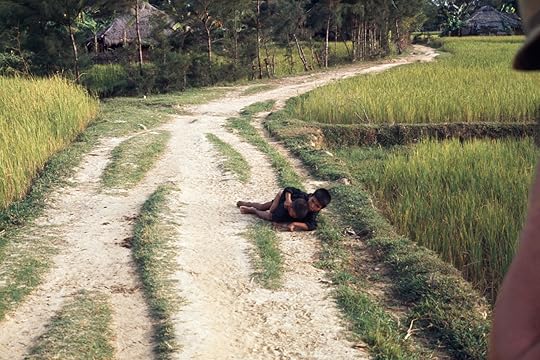 Two children on a trail (Copyright Ronald L. Haeberle)
Two children on a trail (Copyright Ronald L. Haeberle)In 2011, Ron received a message via Facebook that changed his life. The message was from a German cinematographer doing a documentary on a survivor of My Lai 4. He asked if Ron was the My Lai 4 photographer and Ron told him he was. The cinematographer then informed Ron that two children Ron had photographed on a trail in March 1968 were still alive. Ron assumed both had been killed during the massacre. The children, Duc Tran Van and his younger sister, Ha Thi Van, were now adults, with Duc living in Germany and collaborating with the cinematographer on the documentary. The filmmaker asked if Ron would be interested in meeting Duc. Ron was, so much so that he invited Duc and the cinematographer to visit his home in Northeast Ohio. Duc followed-up with an email to Ron a few days later reiterating he was the boy in Ron’s photo.
Duc and the cinematographer visited Ron in September 2011 and they immediately bonded and became friends. After listening to Duc’s account of the events of March 16, 1968, Ron was convinced Duc was the little boy lying on the ground and protecting his sister in the photograph. Duc described a helicopter with white teeth overhead, flying above them on the road. Ron went back and looked at the sequence of pictures he’d taken surrounding the photo of Duc and his sister and saw that indeed, a Huey helicopter with shark’s teeth painted on its fuselage was flying overhead.
Duc told Ron he was trying to escape from My Lai 4 carrying his fourteen-month-old little sister, Ha, who had been wounded in the abdomen. He was trying to get to his grandmother’s village, located about four kilometers from My Lai 4, when they were photographed on the trail. They eventually made it, but their lives were very difficult afterwards. Duc’s mother and two of his four sisters were killed during My Lai 4 and his father did not survive the war. His grandmother was very poor, so they had to scrounge just to find enough to eat. Still, Duc was able to finish school and in 1983, emigrated from Vietnam to East Germany, where he became a machinist. After the fall of the Berlin Wall, he moved to Remscheid, Germany, and continued a successful career repairing machinery. It was then that he met up with the German cinematographer and agreed to work with him on the documentary.
One month after Duc and the cinematographer visited Ron in Northeast Ohio, Ron accompanied them on a trip to My Lai 4. They visited the museum there and found some of the surroundings, including the remains of burned-down buildings, looking just like the scenes Ron captured in his photographs. Ron also met Duc’s sister, Ha, who grew up to be a schoolteacher and now lives in Quang Ngai, not too far from My Lai 4.
Ron, Duc, and Ha consider each other as family. For Ron, learning Duc and Ha had survived the massacre finally brought a measure of hope to an otherwise total human tragedy. Their survival, which was nothing short of miraculous, demonstrated the strength of their spirit and their incredible courage in the face of insurmountable odds. Their example inspires Ron each and every day. For example, Ron recently helped organize efforts to raise $28,000 for flood and typhoon victims in Vietnam. The funds were distributed in two Vietnamese provinces in January 2021.
Voices to Veterans is proud to salute Sergeant Ron Haeberle, U.S. Army, for his service during the Vietnam War. Knowing the headwinds would be great, he helped bring truth to the public when it needed to be told. Moreover, he continues to build bridges across the divides that separate people and understanding. For all he has done and continues to do, we wish him fair winds and following seas.
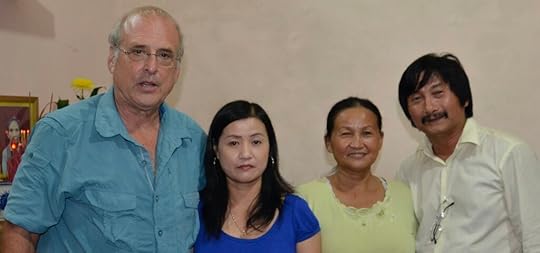 Ron Haeberle with Ha Thi Van, My Thu Van (Duc’s other surviving sister), and Duc Tran Van
Ron Haeberle with Ha Thi Van, My Thu Van (Duc’s other surviving sister), and Duc Tran Van
May 18, 2022
Seaman 1st Class Edward Collins, U.S. Navy – Serving on an Aircraft Carrier in the Pacific War
In the 1965 World War II movie classic In Harm’s Way, the character Commander Paul Eddington, played by Hollywood legend Kirk Douglas, describes the coming war in the Pacific as “a gut bustin’, mother-lovin’ Navy war.” All the men who served on ships in the Pacific theater from the start of the war at Pearl Harbor on December 7, 1941, to the end of the war in Tokyo Bay on September 2, 1945, know just how true that statement was. One of those men was Seaman First Class Edward Collins, U.S. Navy, who joined the fray in 1943 aboard the USS San Jacinto (CVL-30), a light aircraft carrier that participated in all the major Pacific War Navy campaigns in 1944 and 1945. Manning his station on the USS San Jacinto’s flight deck during everything from hurricanes to kamikaze attacks, he lived and breathed the history that has inspired generations of Americans ever since. This is his story.
Ed Collins was born in the tiny coal mining town of Dehue, West Virginia, in 1925. His father, Albert, was a life-long coal miner who spent forty years in the mines, rising to the position of mine foreman. Albert and his wife, Myrtle, made their family’s home on the West Virginia side of the town of Amonate, the main part of which was located just across the border in Virginia. The location was so remote that schools were few and far between. This meant Ed and his brother and sister had to ride a bus through the winding mountain roads to their school in War, West Virginia, over ten miles away.
Ed graduated in 1942 from Big Creek High School in War, West Virginia, just six months after the Japanese Navy attacked Pearl Harbor, bringing America into World War II. After graduation, Ed followed in his father’s footsteps and began working in the coal mines. However, when he turned eighteen in January 1943, he saw enlisting in the military as an opportunity to get out of the mines and do his part in the war. He also knew he would be drafted soon anyway, as all young men were being drafted once they turned eighteen. When Ed told his parents of his decision, they fully supported him. His older brother was already in the Army and the entire country enthusiastically supported the war effort.
Knowing he had his family’s support, Ed headed for the recruiting office in War around April 1943. He had two options, Army and Navy, but Navy seemed like the right way to go. He committed to the Navy and went home to await instructions. One month later, he received the call and reported back to the recruiting office as directed. From there, he and the other new recruits from the area were loaded onto a bus headed for Wheeling, West Virginia, where they raised their right hands and formally enlisted. Then it was off by bus to Naval Station Great Lakes north of Chicago, Illinois, for boot camp.
Boot camp lasted six weeks. Ed’s days began with a mile run around 6:00 a.m. before breakfast, followed by “marching, more marching, some schooling, tests, shots, and more marching.” Despite this rigorous schedule, Ed did not find boot camp difficult having played football and basketball and run track in high school and having worked in the coal mines of West Virginia. After he graduated as a newly minted Apprentice Seaman (E-1), he and the other new sailors were granted a week of leave. Ed used the time to visit his family and then returned to Naval Station Great Lakes to join thousands of other new sailors waiting for their next assignments.
At Great Lakes, Ed learned he had been designated for aviation support training. That meant he and other similarly designated sailors were off for Quonset Point Naval Air Station, located approximately twenty-five miles south of Providence, Rhode Island. There Ed learned how to prepare the Navy’s new Grumman F6F fighter plane for combat missions, working closely with the new pilots training to fly them.
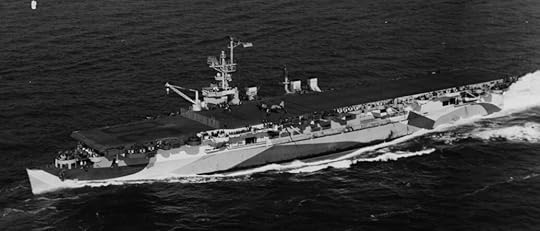 USS San Jacinto (CVL-30) on January 23, 1944 (Source: U.S. Naval History and Heritage Command)
USS San Jacinto (CVL-30) on January 23, 1944 (Source: U.S. Naval History and Heritage Command)After completing his aviation support training, Ed traveled to Norfolk, Virginia, to report aboard USS San Jacinto (CVL-30), a new light aircraft carrier launched on September 26, 1943, and commissioned on November 15, 1943. The ship, which could carry forty-five combat aircraft, was originally intended to be a light cruiser. However, after Pearl Harbor, the need for carrier-based airpower, which could take the fight to the enemy at a much greater distance than surface combatants could, caused the ship to be converted while under construction to a light aircraft carrier.
On January 14, 1944, Ed sailed with the ship on its shakedown cruise. The twenty-seven Hellcat fighters and nine TBM Avenger torpedo bombers of Air Group 51 landed onboard soon afterward and the ship headed for the Caribbean, where the crew gained experience with the new ship’s systems and learned the art of launching and recovering aircraft while underway. On April 2-3, 1944, the ship transited the Panama Canal, beginning its two-year Pacific War campaign. The ship subsequently made stops in San Diego and Hawaii, which Ed remembers fondly even though every place out in town was overrun with servicemembers.
In early May 1944, USS San Jacinto joined Task Force 58 in the Marshall Islands, where its aircraft participated in the fight for the first time by providing fighter cover for task force ships and support for air strikes against Japanese forces on Marcus Island and Wake Island. Throughout these and all subsequent combat operations, Ed played an important role in keeping USS San Jacinto’s planes flying. Applying what he learned at Quonset Point Naval Air Station, Ed served as a plane captain responsible for making sure his assigned F6F Hellcat fighter was ready to go for the pilot when it came time to launch on a mission. This meant doing a pre-flight check of the plane’s gas and oil levels, maneuvering the plane to the correct spot on the flight deck before launch (take-off) and after recovery (landing), starting the plane’s engine to warm it up for the pilot, and making sure the plane was properly tied down so it would not move or be damaged during rough seas.
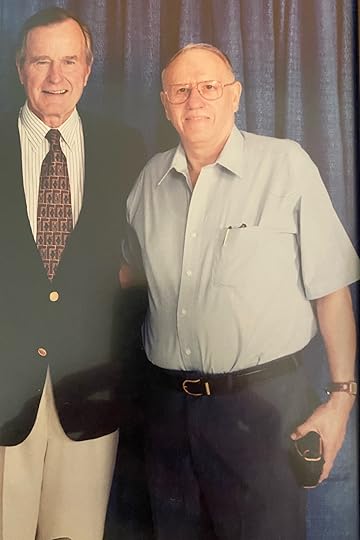 Ed Collins with President George H. W. Bush at a USS San Jacinto (CVL-30) reunion in 1998
Ed Collins with President George H. W. Bush at a USS San Jacinto (CVL-30) reunion in 1998Ed also worked closely with the pilots assigned to his aircraft. He checked their parachutes and gear and helped them get hooked up inside the cockpit. He really admired the pilots, who looked too young to be responsible for flying the planes on such dangerous missions. He thought they were incredibly brave and describes them all as “nice kids”. Although Ed did not know him at the time, one of the nice kids piloting an Avenger torpedo bomber from the USS San Jacinto was Lieutenant Junior Grade George Herbert Walker Bush, who would later become the forty-first President of the United States. On September 2, 1944, Japanese anti-aircraft fire hit Bush’s plane during a mission over the island of Chichi Jima. Bush ordered the crew to bail out over the ocean. Bush survived and was rescued by the submarine USS Finback. The other two crewmembers were never found.
Ed’s job was dangerous, too. As the carrier prepared to launch aircraft, its flight deck was crowded with planes and their whirring propellers as the pilots waited for their turns to take off. If a sailor was not paying attention, he could inadvertently walk into a propeller and be killed instantly. On top of that, throughout Ed’s time in the Pacific, the USS San Jacinto was constantly under attack from Japanese aircraft, including kamikaze suicide planes. During April 1945 in operations supporting the Marines landing on Okinawa, Ed remembers a kamikaze heading for the ship until it was hit by the ship’s anti-aircraft fire at the last minute, shooting off a wing. The plane missed the ship by only fifty feet, exploding as it hit the water. Debris from the kamikaze landed on the flight deck and had to be removed to allow air operations to continue.
On another occasion, Ed was sitting in his assigned F6F Hellcat just after it had been spotted to its position on the flight deck when another plane made a hard landing and crashed into the parked planes. The ensuing chain of collisions started to push Ed’s plane over the side of the ship. Luckily, the wing of Ed’s plane lodged against a gun mount, preventing the plane and Ed from plummeting into the sea. Miraculously, Ed walked away from the incident uninjured.
Another of Ed’s important responsibilities involved damage control. Whenever the ship was at General Quarters and Ed wasn’t otherwise performing his plane captain duties, he was assigned to a firefighting team on the flight deck. This meant if a bomb, torpedo, or kamikaze attack damaged the ship, Ed and the other members of his team were responsible for maneuvering a powerful firehose stowed just below the edge of the flight deck to the site of the fire to put it out. Aircraft carriers like USS San Jacinto, with their stockpiles of bombs and torpedoes always at the ready to arm their embarked aircraft, were particularly vulnerable to fire. If flames were not brought under control quickly, these munitions could set off violent explosions that would doom the ship. Ed and his team knew their lives and those of the entire crew depended on their efforts, so they took their damage control responsibilities very seriously.
Enemy attacks weren’t the only dangers Ed had to deal with. On December 18-19, 1944, after USS San Jacinto and other ships of Admiral “Bull” Halsey’s Third Fleet conducted air raids against Japanese forces on the Philippine island of Luzon, the ships were caught in a powerful typhoon with wind speeds estimated at 160 miles per hour. As the storm hit, Ed managed to get his fighter tied down on the flight deck’s fantail. As he walked away from the plane, he saw a giant wave heading for the ship. The ship tried to turn into it so that its bow would slice through the wave, but the turn started too late. When the wave hit, the ship rolled steeply to one side, causing Ed to drop to the deck to hang on for dear life. Planes on the flight deck not tied down rolled off the deck and fell into the sea. Then the ship rolled back the other way and Ed had to shift his position to keep from sliding off the flight deck in the other direction. Below the flight deck on the hangar deck, a plane broke free and careened into other planes as the ship rocked back and forth from the incessant waves, destroying seven aircraft. The damage USS San Jacinto sustained in the storm took it out of action for about a month as repairs were made by the repair ship USS Hector (AR-7) at Ulithi atoll, the U.S. Navy’s western Pacific staging area. Other ships weren’t so lucky. Three destroyers sank, almost 800 sailors were killed, and many other warships sustained major damage. Admiral Halsey later faced a court of inquiry for allowing the fleet to be caught in the storm.
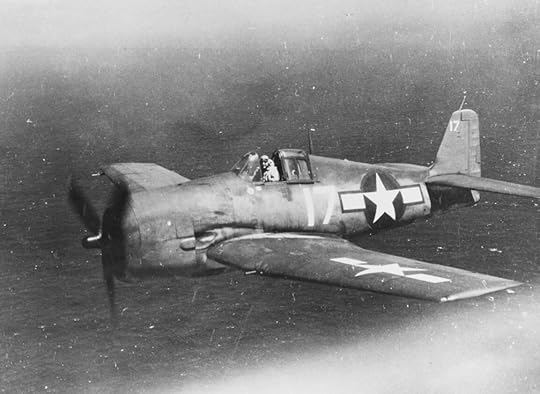 Grumman F6F Hellcat fighter (Source: U.S. Naval History and Heritage Command)
Grumman F6F Hellcat fighter (Source: U.S. Naval History and Heritage Command)When USS San Jacinto was not under threat of enemy air attack (the ship always had to worry about Japanese submarines), life onboard was routine. Ed slept in a rack (the Navy term for a bunkbed) stacked three high. He had a small locker to stow his personal belongings, which were by necessity minimal. Up by 6:00 a.m., he would eat breakfast on the mess deck with the other sailors. His normal fare consisted of beans and a sweet roll, but not the coffee that became a staple for so many of his shipmates. Then it was off to his plane captain duties, keeping his assigned F6F Hellcat fighter clean and in combat ready condition for its pilot to fly. Lunch and dinner were events he looked forward to as they afforded him an opportunity to relax, plus he found the food overall pretty good. He could retire whenever his work was finished and he was done for the day—lights out came at no set time.
One other aspect of Ed’s daily life aboard USS San Jacinto merits mention – the Navy shower. Given the ship’s complement of nearly 1,600 officers and men, fresh water was scarce. That meant everyone took saltwater showers, and even those were limited. To take a shower, Ed would turn on the water for a few seconds to get wet, then turn it off. He would lather up with soap and turn on the water again for a few seconds for a saltwater rinse, and that was it. Still, a short saltwater shower was better than no shower at all.
Occasionally, USS San Jacinto anchored in the huge lagoon at Ulithi atoll, either for repairs as previously noted, or for replenishment and to give the crew a break. During these visits, Ed and his friends were able to go ashore to drink a couple of warm beers, play some baseball on one of the many diamonds carved out on the atoll’s islands, eat a few free sandwiches, and swim at the beach. Thus recharged, the crew would boat back to USS San Jacinto, again ready for the push toward the Japanese mainland.
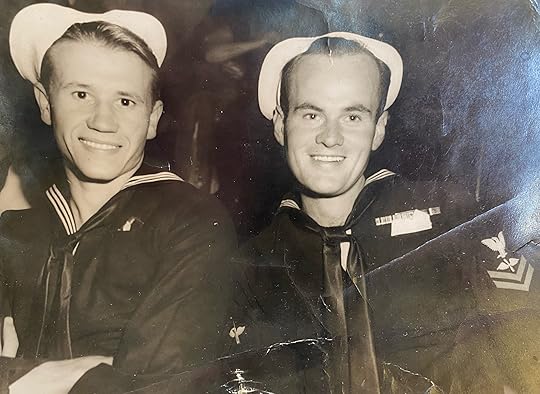 Ed Collins (left) and Petty Officer Bill Montgomery (right)
Ed Collins (left) and Petty Officer Bill Montgomery (right)During a similar stop in Guam, Ed remembers setting out with his supervisor (a Navy Chief) and his best friend, Roy Humes, to find some shoes as theirs were in bad shape. After making some inquiries ashore, they were told to take a jeep a few miles up the road to a supply depot. Doing as instructed, they came across a field where rows upon rows of F4F Wildcat fighters were parked. These fighters were the main fighter aircraft for the U.S. Navy at the start of the war, but had since been replaced by the F6F Hellcat fighter Ed was a plane captain for. They also found an open storage area with crates of supplies stacked everywhere. Eventually, they located the crates with shoes and Ed found two pairs that fit. He threw his old shoes away and put on a new pair, and then with the laces of the other pair tied together, slung the spare pair around his neck. As they prepared to depart, the supply staff told them they could not take the shoes, but the warning fell upon deaf ears. Nothing was going to stop them from finally getting some wearable shoes to take back to the ship.
As a member of USS San Jacinto’s crew, Ed participated in some of the greatest battles in naval history. In June of 1944, the ship and its aircraft fought in the battle for Saipan and the Marianas Islands, where the Japanese sent hundreds of planes to attack the American ships supporting the invasion. Dubbed by U.S. pilots as the “Marianas Turkey Shoot”, over 300 Japanese planes were shot down. It wasn’t just the Navy’s fighter pilots doing the shooting, as the guns aboard USS San Jacinto helped bring down some of the attacking planes, too. To get a sense of the closeness of the combat and the fog of war during the battle, when U.S. carrier aircraft returned to the ship at night after a late afternoon attack on the Japanese fleet, a Japanese pilot somehow mistook USS San Jacinto for his own aircraft carrier and tried to land, only to be waved off and shot down. At the same time, U.S. planes running low on fuel were also trying to land on USS San Jacinto because they could not find their own carriers in the dark. As many planes as possible were permitted to land, although some had to be pushed over the side once aboard to make room on the flight deck for the remaining aircraft trying to land. Those pilots who couldn’t find a friendly aircraft carrier to land on before they ran out of fuel had to ditch their planes at sea, hoping to be rescued.
In August and September of 1944, USS San Jacinto participated in strikes against the Palau Islands, including Chichi, Haha, and Iwo Jima. It was during these strikes that George Bush was shot down during a raid. In October 1944, USS San Jacinto’s planes provided close air support for the U.S. landings on Leyte Island in the Philippines. The ship then fought in the Battle of Leyte Gulf, the largest naval engagement in history. Again, to get a sense of Ed’s closeness to the war, as he manned his General Quarters station on the flight deck, the ship’s gunners shot down two kamikaze planes trying to sink the ship. The ship and its aircraft also provided support for U.S. forces fighting on the Philippine Island of Luzon and, during a temporary excursion from Leyte Gulf to the South China Sea, attacked Japanese airfields on Formosa and Japanese shipping in Hong Kong and Vietnam.
USS San Jacinto remained in Leyte Gulf until “Halsey’s Typhoon” damaged the ship in December 1944, requiring its dispatch to Ulithi for repairs. Then, in 1945, the ship and its planes supported the Marines in the landings on Iwo Jima (February – March) and Okinawa (March – April). The ship continued in the march toward Japan, participating in strikes on the Japanese homeland islands of Honshu and Hokkaido in July and August 1945. When hostilities with Japan ended in mid-August 1945, Ed and USS San Jacinto were operating just off Japan’s coast. After its air group flew some mercy missions airdropping food and supplies on Japanese camps holding U.S. prisoners of war, USS San Jacinto returned to Naval Station Alameda, California, on September 14, 1945. The ship was awarded the Presidential Unit Citation for its wartime efforts.
Although USS San Jacinto’s war was over, Ed’s service was not because he hadn’t accumulated enough demobilization points to be immediately discharged. As a result, in early 1946, he made one more trip on USS San Jacinto to pick up and bring home U.S. soldiers from the Philippines. To accommodate the thousands of soldiers who would ride USS San Jacinto back to the States, multi-tiered bunks were installed on the hangar deck where the ship’s planes were previously repaired and prepped for battle. When the ship pulled into Manila Bay to pick up its passengers, Ed got the opportunity to go ashore and walk around. He found Manila devastated, with few buildings still standing. Despite the utter destruction, he was surprised to see Filipinos selling name brand American liquors of every type to any American who would buy them. It was a sign that even in times of despair, the entrepreneurial spirit was alive and well and that the Philippine economy would surely recover. Ed’s stay in Manila was short-lived, as the ship soon set sail now crowded with so many soldiers that it stressed every aspect of shipboard life. Just getting a meal meant waiting in line for hours, although as ship’s company, Ed had head of the line privileges.
When USS San Jacinto arrived back in Alameda, Ed, now a Seaman First Class (E-3), finally had enough demobilization points to be discharged. To make that happen, he was transferred to Toledo, Ohio, where he received his discharge papers. He then joined his family in Sandusky, Ohio, where his parents had moved and opened a small neighborhood grocery store after Ed’s father retired from working in the coal mines. Ed soon found a job building the fourteen-acre New Departure ball bearing plant, which supplied General Motors with ball bearings and began operations in June 1947. When his construction job finished, Ed was hired by New Departure as a crane operator. He worked for New Departure until he retired after thirty-five years.
Once settled in Sandusky, Ed married his wife, Jenny, and together they raised five children. Sadly, Jenny passed away in 1987. Ed later married his second wife, Pat, but she has also since passed away, as has his youngest daughter, Mary Ann. Ed is still fortunate, though, to have four of his children to share his life with.
Ed’s experience on USS San Jacinto proved to be a defining experience in his life. He is proud to have served his country and for many years attended reunions of the USS San Jacinto’s crew. He even got to meet and have his picture taken with President George H. W. Bush at the reunion in 1998, which was held at the Presidential Library in College Station, Texas. When the reunions began in the 1980s, hundreds of former shipmates attended. For the 2007 reunion in Charleston, South Carolina, just eight veterans were able to attend, so organizers decided that would be the final event. Still, the friendships Ed made onboard USS San Jacinto almost eighty years ago are forever etched in his memory.
Voices to Veterans is honored to salute Seaman First Class Ed Collins, U.S. Navy, for his distinguished service onboard USS San Jacinto (CVL-30) in the Pacific theater of operations during World War II. By keeping his assigned aircraft flying and courageously defending his ship throughout months of sustained and determined attacks by Japanese forces, he directly contributed to bringing the war to a successful end. We are thankful for his faithful service and commitment to our country. Most of all, we wish him fair winds and following seas.
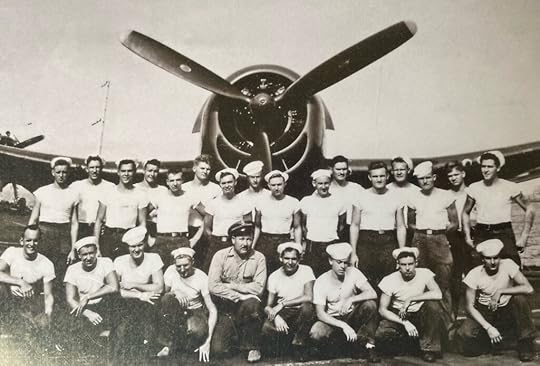 Ed Collins (bottom row, 2nd from left) with his F6F Hellcat fighter support team aboard USS San Jacinto (CVL-30)
Ed Collins (bottom row, 2nd from left) with his F6F Hellcat fighter support team aboard USS San Jacinto (CVL-30)
March 16, 2022
Technical Sergeant Mark Himmer, U.S. Air Force – Service is a Family Affair
Many people who serve in the military are inspired to do so by a family member or friend who served before them. Oftentimes the role model is a parent or grandparent, an aunt or uncle, or even a brother or sister. Technical Sergeant Mark Himmer, U.S. Air Force, had two family members in whose footsteps he followed. He also had the unique experience of serving with one of them for fourteen of the fifteen years he spent in the Minnesota Air National Guard. This is Mark’s story.
Mark was born in 1972 in Rochester, Minnesota, the home of the Mayo Clinic, and grew up just west of Minneapolis in St. Louis Park. His parents divorced when he was young, so he spent lots of time with his paternal grandparents on their farm and with his maternal grandparents in small town not far away. At both places, he was constantly in contact with aunts, uncles, and cousins, making his family very close-knit on both sides.
When Mark visited his maternal grandparents, he listened to his grandfather, Joseph Ellis, talk about his experiences in Europe during World War II. His grandfather wouldn’t go into detail because the memories were painful, but Mark learned that he had been a halftrack driver in the 36th Armored Infantry Regiment. All the men he’d become close friends with were killed in combat, with replacement soldiers filling in behind them. As a result, Mark’s grandfather found it hard to make friends with the replacements, fearing they would be lost, too. Mark’s grandfather was his hero and he always looked up to his grandfather for having fought in World War II.
Mark had another powerful influence on his father’s side – Dave Himmer, his father. Mark’s father is a decorated Army veteran from the Vietnam War, who went on to do a stint in the Marine Corps followed by a long career in the Minnesota Air National Guard. Watching his dad progress to Command Chief Master Sergeant, the highest Air Force enlisted rank, couldn’t help but influence Mark in a positive way. Add to that the movie Top Gun, a hit 1986 movie about Navy fighter pilots, and Mark knew the military was for him.
In 1986, though, Mark was still in middle school. He and his sister had both gone to a private elementary school, but when it came time for middle school, Mark’s father gave them a choice. They could go to public school or, if they wanted to continue going to a private school, they had to contribute to the tuition. Mark’s sister chose to shift to a public school, but Mark liked where he was and set out to earn his way. In eighth grade, he took a job at a Burger King. Then, when he transitioned to Benilde-St. Margaret’s High School in 1987, he worked as a janitor at the school over the summer and during the school year after football and track practice. As if that wasn’t enough, he also worked at a grocery store and a local sporting goods store. Although it was tough, Mark considers his dad’s tuition requirement to be one of his great life lessons because earning his way through school gave him the confidence to know that if he worked hard, he could accomplish whatever he set out to do.
As Mark prepared for his senior year of high school in August 1990, Iraq invaded Kuwait and the United States began to deploy military forces to the Middle East to support its ally. The operation, known as Desert Shield, began with a build-up of coalition forces in preparation for retaking Kuwait from Saddam Hussein’s Iraqi forces. With the United States heading toward war, Mark felt duty bound to do his part, so he told his dad he wanted to enlist. His dad, who was now serving in the Minnesota Air National Guard’s 133rd Airlift Wing, recommended Mark check out the Air National Guard before visiting any other recruiters. On January 16, 1991, the U.S. led coalition launched Operation Desert Storm to remove Iraqi forces from Kuwait. Three days later, Mark enlisted in the Minnesota Air National Guard’s delayed entry program.
The delayed entry program meant Mark didn’t have to report to Basic Training immediately – he could complete high school first. He did, however, begin to drill with the 133rd Airlift Wing while he was still in school. On June 27, 1991, two weeks after he graduated from Benilde-St. Margaret’s High School, Mark boarded a plane heading for Basic Training at Lackland Air Force Base in San Antonio, Texas. Air Force training instructors were waiting for the new recruits as soon as they got off the plane, directing anyone they saw with a single carry-on bag and a manila envelope to get in line. From there they went to Lackland Air Force Base by bus and their training began in earnest.
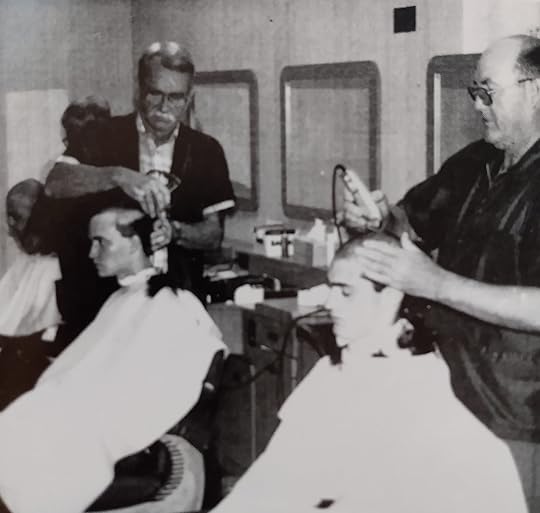 Mark Himmer getting his first haircut at Basic Training (closest chair)
Mark Himmer getting his first haircut at Basic Training (closest chair)The most memorable aspect of Basic Training for Mark was the oppressive Texas heat. His training unit, known as a “flight”, spent much of the day indoors in classes unless they had to be out in the field. In the classroom the temperature was around 68 degrees. When they would go outside for an activity, the summer sun could crank up the thermostat to a blistering 110 degrees, which was especially difficult for recruits like Mark from the north. When it was simply too hot to train in the sun, the recruits conducted their outside activities under buildings built on stilts to provide some relief from the heat. Mark survived, partly because he was in great shape from running track and playing football in high school. He graduated from Basic Training in August 1991.
The end of Basic Training brought no end to the Texas heat because immediately after graduation, Mark reported to his follow-on Combat Arms Training and Maintenance (CATM) Technical School, located just on the other side of Lackland Air Force Base. There Mark trained to become qualified for his job specialty, CATM Instructor. This meant when he graduated from Technical School, he would be a qualified weapons instructor for the 133rd Airlift Wing, responsible for running the base weapons range and training the men and women assigned to the various units comprising the 133rd Airlift Wing to use their weapons safely and effectively.
Mark loved CATM Technical School because he enjoyed working with weapons. Not only did he have great instructors who prepared him well for his future responsibilities, but he also spent lots of time learning how to instruct others, firing the weapons he was responsible for on the range, and focusing on safety. Despite that focus on safety, sometimes others had different ideas of what safety meant. Mark learned this when some Marine Dog Handlers were training on the range with an M203 grenade launcher. He watched as a Marine put on a flak jacket, a helmet, and thick, heavy razor-wire protective gloves, and then took off running out onto the range. Once he got far enough out, another Marine fired an M203 training round in the direction of the well-clad Marine, who somehow managed to catch the training round in his gloves. When the round exploded, it spewed fluorescent orange spotter powder all over the Marine. Mark chalked the incident up to differing service cultures on safety.
After graduating from CATM Technical School on his birthday, October 15th, Mark reported to his unit, the 133rd Security Forces Squadron of the 133rd Airlift Wing, in November 1991. The unit drilled at the Minneapolis-Saint Paul Joint Air Reserve Station, located at the Minneapolis-Saint Paul International Airport. The Wing operates eight giant four-engine C-130 “Hercules” transport aircraft, and the 133rd Security Forces Squadron provides security for the aircraft and associated buildings, equipment and personnel.
Although Mark was just an Airman Basic (E-1), he quickly learned how much trust his unit placed in him. During his first week at the base range, a colonel was flagging people with his .38 caliber revolver. Mark took him aside, unloaded his weapon, and politely indicated he was finished on the range for the day because he was endangering the others training on the range. The colonel protested, saying he would take up the matter with the commanding general. A non-commissioned officer interceded and told the colonel that on the range, Airman Basic Himmer acted with the authority of the commanding general and that was the way it had to be. Mark never heard anything from the colonel again.
As with every Air National Guard member, Mark’s commitment involved drilling one weekend each month and two full weeks each year, although the actual commitment often exceeded that minimum amount. Mark trained Wing and base personnel on a wide range of weapons, including the .38 caliber revolver; the M9 Baretta pistol; the M16A2 and M4 rifles; the 12-guage shotgun; and the M60, M240B, and M249 machine guns. On his off-duty time, he began studying to be a medical lab technician and in 1995 became engaged to his fiancé, Joy. He also continued to progress in the Air National Guard, promoting to Staff Sergeant (E-5) on February 1, 1996. At that point, he decided to change his job specialty to C-130 loadmaster because he wanted to fly with the Wing’s C-130s. That meant attending C-130 Loadmaster School with the 189th Airlift Wing at Little Rock Air Force Base in Little Rock, Arkansas.
 Mark Himmer (third from left) at Loadmaster School at Little Rock Air Force Base
Mark Himmer (third from left) at Loadmaster School at Little Rock Air Force BaseLoadmaster School was the toughest training Mark ever experienced. The course began with a video showing a real C-130 loading mishap that killed the plane’s entire crew, driving home the point that if they didn’t do their job right, people could die. The grading scale reflected the serious nature of the work, where it often took a perfect score of 100% to pass many portions of the coursework. Mark also had to learn to calculate the weight and balance measurements by hand for stowing cargo on the plane, as improperly distributing the cargo and passengers in the cargo bay or misjudging the plane’s fuel burn rate could prove catastrophic.
The high point of the school for Mark was his C-130 “familiarization” ride. During this ride, the pilot flew their C-130 to 10,000 feet and Mark’s instructor lowered the big cargo loading ramp at the rear of the airplane. Wearing a parachute and a harness attached to the floor, Mark walked to the outer edge of the ramp. After a few seconds, the pilot pointed the nose of the aircraft upward, allowing Mark to hang in midair behind the plane until he was slowly brought back on board. Mark found the experience exhilarating.
Mark completed the Basic Loadmaster Course in November 1996 and reported to his new unit, the 109th Airlift Squadron, which was the C-130 squadron located on the Minneapolis-Saint Paul Joint Air Reserve Station. Once there, he learned the time-commitment expected of him would greatly exceed what he had been led to believe, including three to five nights per week. After talking this over with Joy and his father, Mark approached his previous unit, the 133rd Security Forces Squadron, and found his old job as a Combat Arms Supervisor/Security Forces Craftsman had not been filled and they wanted him back. Accordingly, he disenrolled from the Loadmaster program and began drilling again with the 133rd Security Forces Squadron.
Mark married Joy in October of 1997 and continued with his Minnesota Air National Guard duties. In March 1999, he deployed with his unit to Anderson Air Force Base in Guam to participate in Operation Tandem Thrust, a large joint military exercise involving forces from the United States, Australia, and South Korea in the Western Pacific. He did similar deployments later in 1999 and 2000 to Puerto Rico, Costa Rica, and Colombia in support of Operation Coronet Oak (providing security for C-130s participating in counter-drug operations) and to Curacao in support of Operation Coronet Nighthawk (providing security for F-16s from the Duluth, Minnesota, Air National Guard base conducting counter-drug operations).
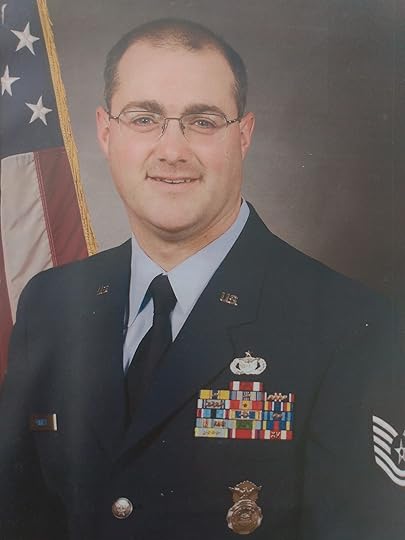 Technical Sergeant Mark Himmer, U.S. Air Force
Technical Sergeant Mark Himmer, U.S. Air ForceIn February of 2000, Mark was approved for a full-time Active Guard/Reserve (AGR) position with the 133rd Security Forces Squadron, meaning he was now on active duty with the squadron on a full-time basis. He was also offered an opportunity he could not refuse. The Air Force had a new security program known as Phoenix Raven, where specially trained security personnel flew on transport aircraft like the 133rd Airlift Wing’s C-130s whenever their missions took them to high-risk areas. Although Mark did not have the training to be officially designated as Phoenix Raven qualified, he did have the training and experience to serve as an apprentice under a Phoenix Raven qualified supervisor whenever the mission required two persons instead of one.
During a Phoenix Raven mission in the spring of 2000, Mark had a harrowing experience. In his capacity as an apprentice, he and his supervisor flew on a C-130 from Minnesota to Georgia and then on to Costa Rica. After allowing for the necessary crew rest (and doing some whitewater rafting), the mission was to continue into Colombia. However, at this point a second C-130 joined the mission. To accommodate the change, Mark and his supervisor split up, one providing security for each aircraft. As Mark’s plane was en route to Bogota, the word was passed to the crew to change into civilian clothes because a bounty had been placed on U.S. servicemembers by the various drug cartels in South America.
After Bogota, the two C-130s continued to a dirt airstrip near Colombia’s border with Venezuela. Mark’s plane landed first and Mark met with the individual responsible for airstrip security, a special forces type wearing a cowboy hat and boots. He asked Mark whether the planes would be staying overnight. Mark asked why and the man told him they were sure to take small arms fire and mortars overnight if they stayed. When Mark relayed that to the aircraft commander, he told Mark they would definitely be “wheels up” before dark.
Mark then started walking down a path leading to a sandbagged defensive position. He had to go to the bathroom and was looking for an appropriate place to do so. As he was walking, someone sped toward him on a minibike. Mark prepared to draw his weapon, but soon realized the individual was part of the Colombian paramilitary force protecting the airstrip. With the man speaking broken English and Mark speaking broken Spanish, Mark learned he was walking toward a minefield. In fact, there was a “Bouncing Betty” mine just twenty feet further down the path he was walking on. This close call made a lasting impression on Mark, as he realized if he had taken a few more steps, he might not have made it home alive. The mission was one of two times Mark qualified for hostile fire pay.
Once back in Minnesota, Mark and his supervisor prepared an in-depth security profile for the Colombian airfield, including a detailed sector sketch. The profile received national attention and served as a benchmark for future National Imagery and Mapping Agency security surveys.
Over the summer of 2001, Mark prepared with his unit to deploy to Incirlik Air Base in Turkey to fill in for an active-duty unit while its personnel took leave. Mark’s unit was scheduled to depart on September 12th, so Mark was at home on September 11th packing when he saw terrorists crash hijacked airliners into the World Trade Center and the Pentagon. He immediately called the squadron’s Desk Sergeant, who told him to report to the squadron and to tell his wife he did not know when he would be coming home.
On his way to the base, Mark saw F-16s flying combat air patrol overhead. Once at the squadron, he learned everyone assigned to the base was being recalled. Despite the chaos, Mark’s unit continued preparations to deploy to Incirlik, which it did on September 15th. Once there, Mark and the rest of his unit were told to drop their gear on the cots in their tents (not on the floor where scorpions might crawl into it) and report for an immediate briefing. At the briefing, they were informed they were in lockdown and would remain in Incirlik for a year because every person would be needed to support future operations. After the briefing, Mark called his dad and his wife to give them the news. It was a particularly difficult call for Joy because she had just given birth to their first daughter in May. Now she was going to be on her own for a year with their new baby girl.
After a week in Turkey, the situation changed. Mark was told the Minnesota Air National Guard leadership had pressed to have its AGR personnel like Mark return to keep their units functioning, so Mark and the rest of the 133rd Security Forces Squadron returned to Minneapolis in early October. This was the second mission for which Mark qualified for hostile fire pay and was a precursor to Operation Enduring Freedom, which involved U.S. forces engaged in combat operations in Afghanistan and elsewhere in the Global War on Terrorism.
Mark subsequently deployed to MacDill Air Force Base in Tampa, Florida, from October through December 2001 as a squad leader and again from May through August 2002 as the team chief. These last two deployments were in support of Operation Noble Eagle, which involved the mobilization of Guard and Reserve personnel to provide security for military installations and potential terrorist targets across the United States. During one of these deployments, Mark received a General Tommy Franks’ challenge coin in recognition of his work revamping the base Armory’s personally owned weapons program. General Franks, who was the four-star Commanding General of the U.S. Central Command directing U.S. operations in the Middle East, saw Mark’s work at the Armory and instructed his staff to award Mark the coin.
In the summer of 2002, Mark began a project that would have a lasting impact on his unit. Having always been interested in unit heraldry and patches, he received permission from his unit and Wing leadership to design a unit patch for the 133rd Security Forces Squadron. Working closely with his wife (a graphic artist), they designed a patch and got it approved for use by the Army Heraldry Office on October 6, 2004. The patch includes across the top a Latin motto selected to represent the squadron: “Defensor Boreas”, which means Defenders of the North.
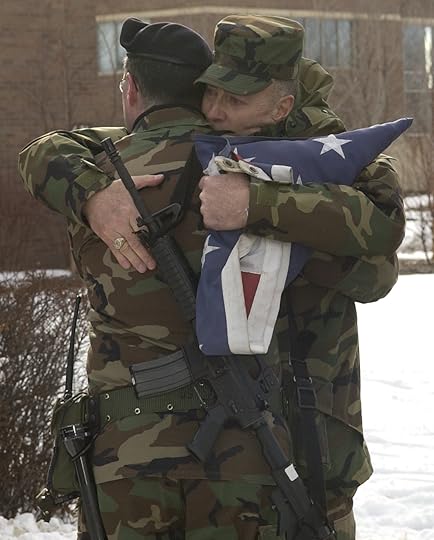 Mark Himmer (in beret) hugging his father at his father’s retirement
Mark Himmer (in beret) hugging his father at his father’s retirementMark continued on active duty through September 2005. This gave him the opportunity to participate in his dad’s retirement ceremony that same year. His dad’s retirement was a big event for the 133rd Airlift Wing because his dad was the Command Chief Master Sergeant, the senior enlisted leader in the Wing and on the base. Mark spoke at the ceremony and was able to give his dad a hug at the end before heading back to his squadron for duty. Mark was honored to serve with his father, who instilled in him the importance of always doing the right thing, no matter what the cost. He also gave Mark three rules to live by which proved their value to Mark time and time again: always complete required training and qualifications, don’t let opportunities slip by, and above all, take care of your people.
On January 18, 2006, Mark left the Minnesota Air National Guard. At the time of his separation, he was the non-commissioned officer-in-charge of the Security Forces and Base Armory, responsible for making sure deploying Wing and base personnel had serviceable weapons to support their assignments. He was also a member of the base Honor Guard, performing at ceremonies, parades, funerals, and recruiting events.
After his separation, Mark returned to being a full-time civilian. Having earned his bachelor’s degree in Healthcare Management from Touro University International in September 2004, he began a career in healthcare. He currently works for United Health Group Optum as a project coordinator. He and his wife Joy have three daughters and are enjoying life in suburban Minneapolis.
Despite being a full-time civilian, Mark keeps his military ties alive through his service in the American Legion and the Veterans of Foreign Wars (VFW). In fact, he is a life member of the VFW and Senior Vice Commander of VFW Post 7051 in Crystal, Minnesota. He has also served for many years as a Minnesota Youth Firearms Instructor for the Minnesota Department of Natural Resources, teaching youth how to use firearms safely and responsibly.
Mark’s military awards include the Meritorious Service Medal; the Air Force Commendation Medal (second award); the Air Force Achievement Medal (second award); the Air Force Outstanding Unit Award (fifth award); the Air Force Reserve Meritorious Service Medal (fifth award); the National Defense Service Medal (second award); the Humanitarian Service Medal; the Air Force Expeditionary Service Ribbon with Gold Border (third award); the Armed Forces Reserve Medal with 10-year bronze hourglass device, “M” for mobilization and “2” for two deployments; the Air Force Expert Ribbon (rifle and pistol); the Air Force Basic Training Ribbon; the State of Minnesota Activation Ribbon, and the State of Minnesota Good Conduct Ribbon (XV for fifteen years of service).
Voices to Veterans is proud to salute Technical Sergeant Mark Himmer, U.S. Air Force, for his fifteen years of service in the Minnesota Air National Guard. Over that period, Mark trained countless individuals and deployed around the world to protect U.S. Air Force assets and personnel. Even now, he continues to serve his community through the American Legion and VFW and by teaching gun safety to Minnesota’s youth. We thank him for all he has done and wish him fair winds and following seas.
 133rd Security Forces Squadron patch
133rd Security Forces Squadron patch
February 23, 2022
AB2 Keith Bunton, U.S. Navy – Serving on USS Essex During the Korean War
Less than five years after the end of World War II, the United States again found itself at war, this time on the Korean Peninsula fighting Communist aggression. Despite 1.8 million U.S. military members serving in the theater of operations during the bloody three-year conflict, Americans know little of their service and sacrifice. Aviation Boatswain’s Mate Second Class Keith Bunton, U.S. Navy, experienced the Korean War off the shores of Korea onboard the aircraft carrier USS Essex (CVA 9), which launched airstrikes against enemy targets during two Korean War deployments. This is Petty Officer Bunton’s story.
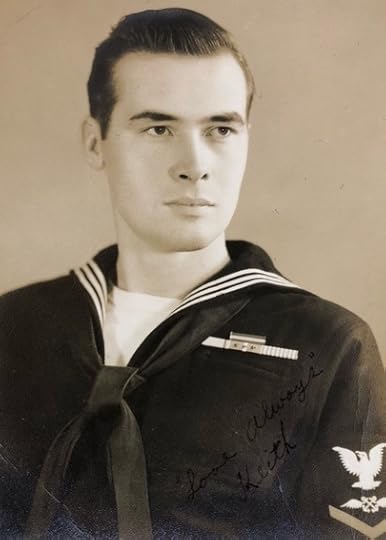 Petty Officer Keith Bunton, U.S. Navy
Petty Officer Keith Bunton, U.S. NavyKeith Bunton was born in rural Missouri in 1931 and lived there until he was eight years old. His family then moved to a place in the country outside Memphis, Tennessee, so his father could raise greyhounds for racing. The family spent their summers in Memphis and then loaded the dogs into kennels mounted on the back of their 1937 Chevy pickup truck for the three-day trip to Jacksonville, Florida, where they stayed with the dogs as they raced over the winter. After the winter racing season ended, they packed up their belongings and returned to Memphis to start the cycle over again. Eventually, Keith’s father was able to build a house in Jacksonville and the family moved there permanently near the end of November 1941. Two weeks later, Keith was playing on the floor in the living room when he heard on the radio Pearl Harbor had been attacked and the United States was at war.
Keith’s father worked at Naval Air Station Jacksonville throughout World War II. When Keith was sixteen, his father started a chicken farm across the St. John’s River from downtown Jacksonville. Keith worked on the farm, too, and the hard physical labor kept him in great shape. Then, on June 27, 1950, the Korean War broke out when North Korea crossed the 38th parallel and invaded South Korea. The United States came to South Korea’s defense, as did other countries serving under the flag of the United Nations.
With the Korean War raging and his father having quit the chicken business, Keith enlisted in the Navy in January 1951. After being inducted in Jacksonville, he boarded a train on a Monday evening and arrived in San Diego for boot camp on mid-Friday afternoon. Since he was already in great shape, he did not find boot camp difficult, although it did bulk him up. When he arrived in San Diego, he was 6’4” and weighed 155 pounds. When he graduated from boot camp less than two months later, he weighed 180 pounds—the most he’s ever weighed in his life.
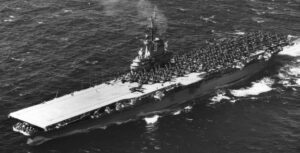 USS Essex (CVA 9) in 1951 with embarked air wing (Source: U.S. Navy)
USS Essex (CVA 9) in 1951 with embarked air wing (Source: U.S. Navy)Now a Seaman Apprentice (E-2), Keith received orders to report to the USS Essex (CVA 9), a famous aircraft carrier that had participated in numerous campaigns in the Pacific during World War II. The Essex had recently arrived in San Diego after completing a two-year overhaul in Bremerton, Washington. Keith arrived onboard at the end of March 1951 and by August he was underway with the ship headed for the Korean War.
Keith spent his first fifteen months working on the carrier’s flight deck. The job was dangerous even during peacetime because the whirring propellors and jet engine intakes of the ship’s embarked aircraft were unforgiving if a sailor came too close. Keith’s primary job on the flight deck was to refuel the aircraft prior to their launch. To refuel the F-9F Panther jet fighter, the plane had to be positioned so its main landing gear was only about two feet from the edge of the flight deck toward the bow on the starboard (right) side. Then Keith would connect a two-and-a-half-inch fuel hose originating under the flight deck to jet’s fuel tanks after climbing up a ladder onto the wing.
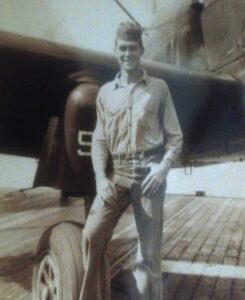 Keith Bunton onboard USS Essex
Keith Bunton onboard USS EssexWhen a new sailor tried refueling an F-9F Panther for the first time, all the experienced sailors in the area gathered around to watch. As the jet’s fuel tanks reached about half-full, the landing gear strut near the edge of the ship would suddenly jerk down two or three inches from the weight of the fuel. The rookie sailor on the jet’s wing would frantically try to grab onto anything he could, fearing he was about to plummet off the ship together with the jet. The scene never failed to delight the gathered onlookers.
Other incidents had far more serious consequences. Occasionally, a plane returning from a combat mission would have problems landing and slide off the flight deck into the sea. On September 16, 1951, a combat damaged F2H Banshee jet fighter jumped the barriers when trying to land and crashed into other aircraft staged on the carrier’s flight deck. Seven men died and the Essex had to pull into Yokosuka, Japan, for repairs. On another occasion a sailor was severely injured when a parked plane’s jammed gun suddenly opened fire. Sometimes, though, the ship got lucky and no one would be injured. Keith remembers a plane landing with a bomb still under its wings when the bomb detached and skidded down the flight deck. Before it could explode, a sailor ran over to it, picked it up, and threw it over the side of the ship into the water.
Although Keith’s living quarters were cramped, he describes them as much better than what men in the other services had to endure in Korea. He lived below decks in a compartment with seventy other men, their racks (bunks) stacked three high. Each sailor was assigned two gray wool blankets and a locker to stow his personal belongings. Keith folded one of his blankets and used it to extend the length of his mattress because the Navy-issued mattress was too short for his 6’4’’ frame. When Keith wasn’t on duty or asleep in his rack, he spent a lot of time reading books as there was little else to do for entertainment.
The Essex returned to San Diego from her first Korean War deployment in March 1952. Just four months later, and after Keith was able to take some well-deserved leave back in Jacksonville, the Essex deployed again for a second Korean War deployment, departing San Diego in July 1952. For Keith, this cruise began much like the last one ended, with him continuing to work as an Aviation Boatswain’s Mate on the carrier’s flight deck. However, after he’d been on board a total of fifteen months, he was assigned below decks to the gasoline filter room, where he was responsible for opening and closing valves that controlled the flow of aviation fuel. When General Quarters sounded, he had three minutes to get from wherever he was to his duty station in the gasoline filter room, which required him to pass through four watertight steel hatches. He found this a little unnerving because as hard as it was to get through those doors to his station, he knew it would be even harder, if not impossible, to get out if something went wrong.
During both of Keith’s wartime deployments, the Essex made several port calls along the way. These stops included Pearl Harbor at the beginning and end of each deployment, Yokosuka, Japan, and Subic Bay in the Philippines. Keith remembers Subic Bay being intolerably hot and uncomfortable because the ship had no air conditioning. In Yokosuka, he remembers visiting Yokohama just north of Yokosuka and seeing cars burning charcoal for fuel instead of gasoline, an alteration made necessary by oil shortages during World War II.
After the Essex returned to San Diego from its second Korean War deployment in January 1953, Keith transferred to Moffett Field, located in Santa Clara County, California, at the south end of San Francisco Bay close to what is now Silicon Valley. Keith was assigned to Transport Squadron VR-5, which operated four-engine Douglass R6Ds (DC-6s) out of one of the giant blimp hangars built by the Navy during the 1930s and 1940s to support its dirigible program. The blimp hangars were so gigantic they could accommodate five of the big R6Ds from Keith’s squadron and five more from another squadron.
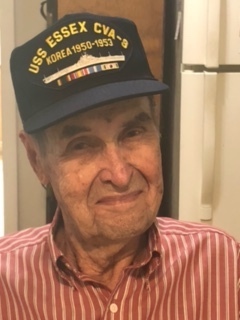 Keith Bunton
Keith BuntonKeith’s job at Moffett Field involved directing aircraft taxiing back to the hangar area to their assigned parking spots. When not on duty, Keith and his friends would head to the Enlisted Men’s Club when it opened at 4:00 p.m. for a few beers and then hurry to the chow hall for dinner by 5:45 p.m., just fifteen minutes before the facility closed. Keith also spent a lot of time touring Palo Alto and San Jose, but never made it to San Francisco, despite being so close.
Keith served out his enlistment at Moffett Field and was honorably discharged in December 1953 as an Aviation Boatswain’s Mate Second Class (E-5). He returned to Jacksonville, Florida, got married, and began a long civilian career working as an aviation metalsmith at Naval Air Station Jacksonville. He worked at Naval Air Station Jacksonville for thirty-two years, finally retiring in 1986. He has two wonderful children, his son, Chris, and his daughter, Melinda. As he looks back over his ninety-one years, he sums it by saying “I’ve had a good time in life”.
Voices to Veterans is proud to salute Aviation Boatswain’s Mate Second Class Keith Bunton, U.S. Navy, for his distinguished service aboard USS Essex during the Korean War and for his thirty-two years of service as an aviation metalsmith at Naval Air Station Jacksonville. His nearly four decades of service helped bring democracy to South Korea and preserved Navy combat readiness. We thank Keith for all he has done for our country and wish him fair winds and following seas.



